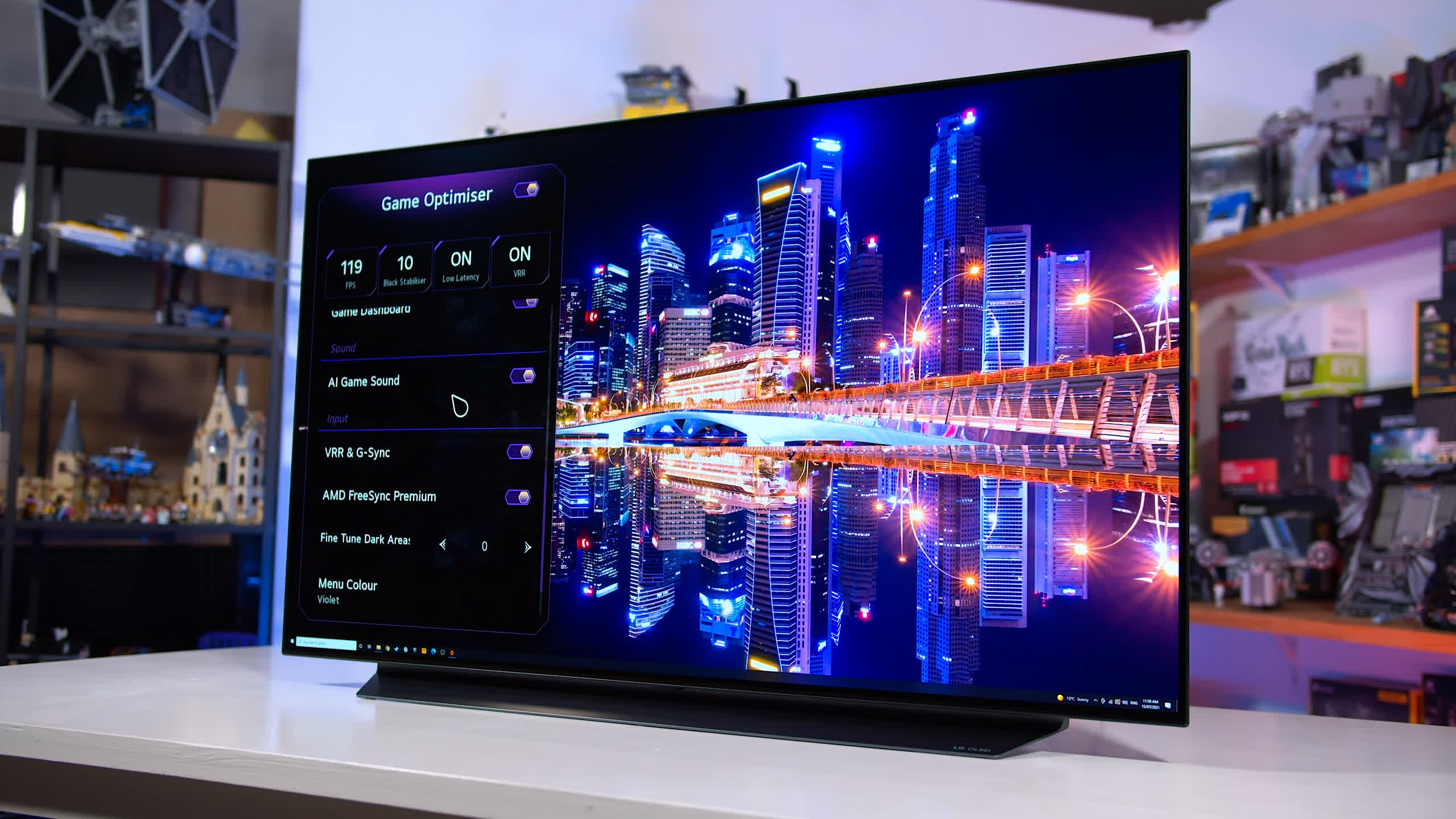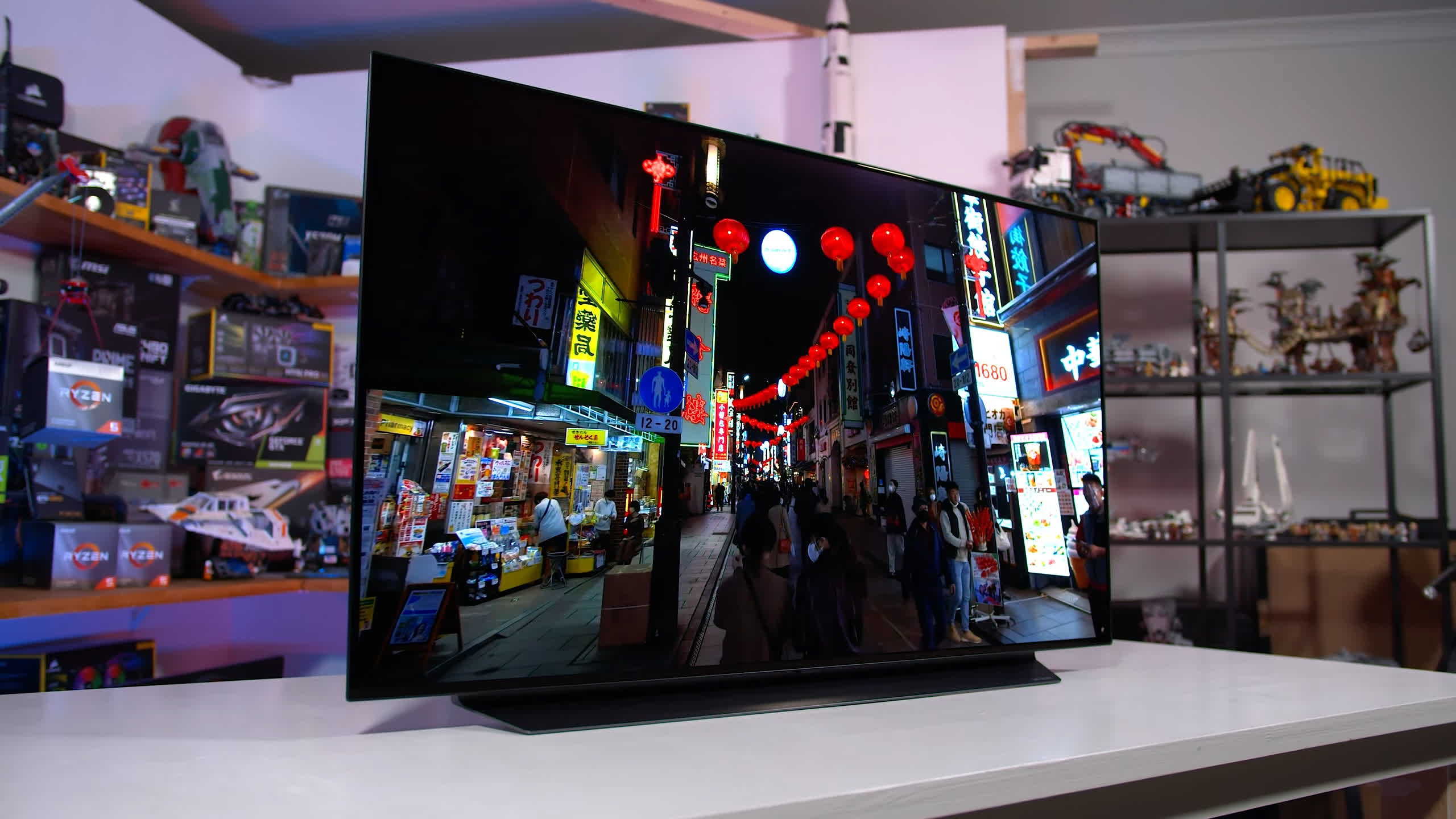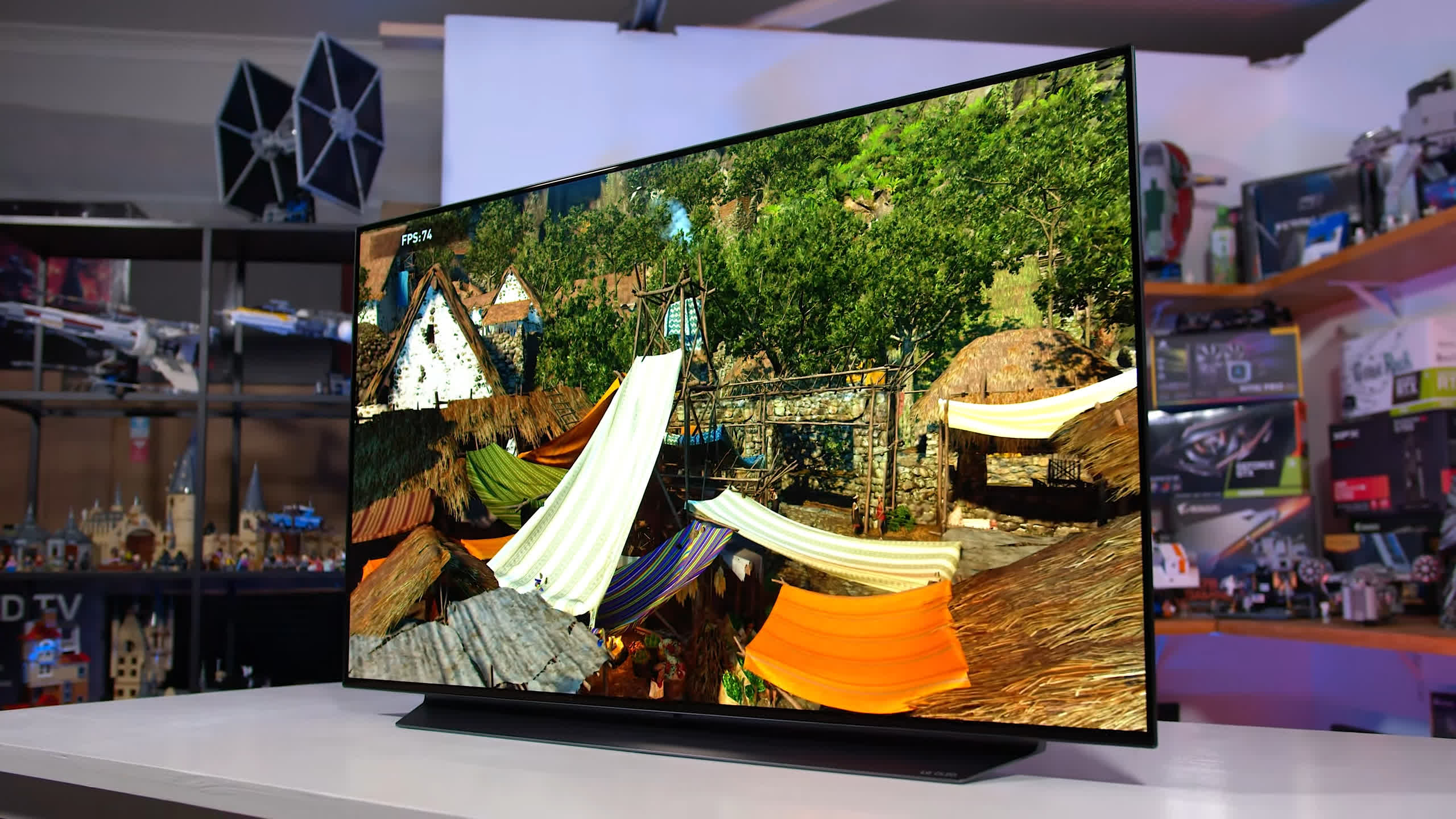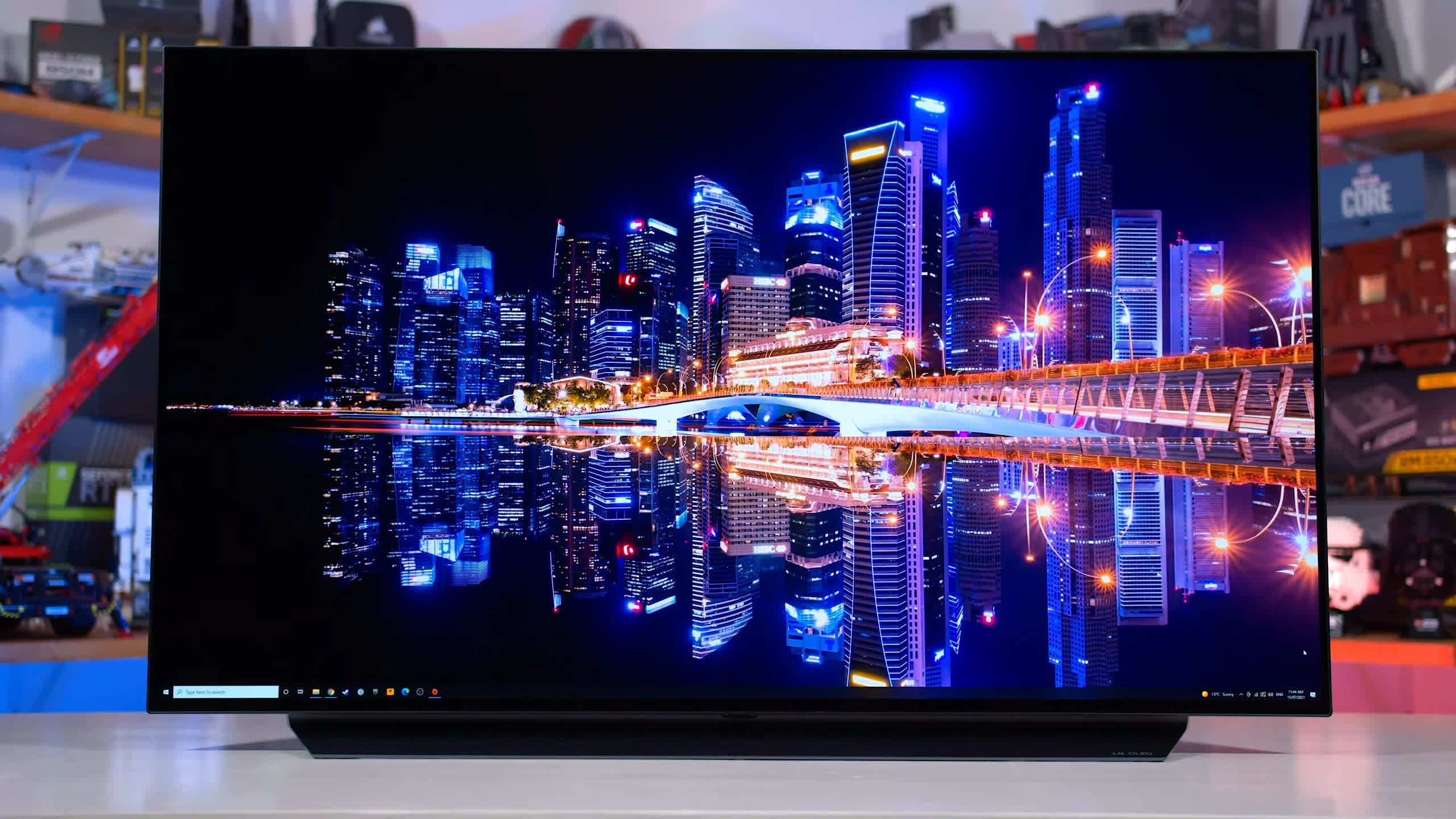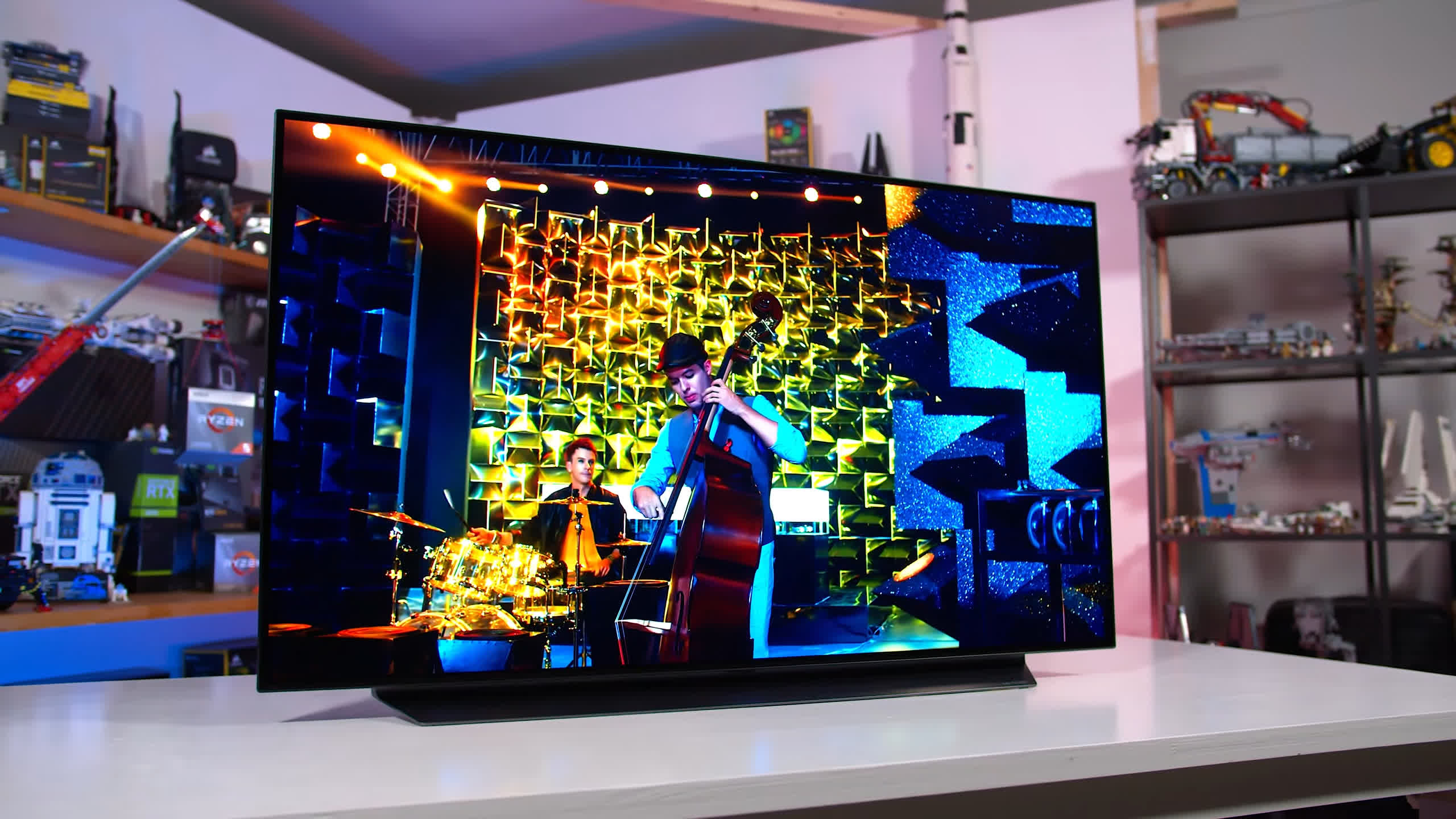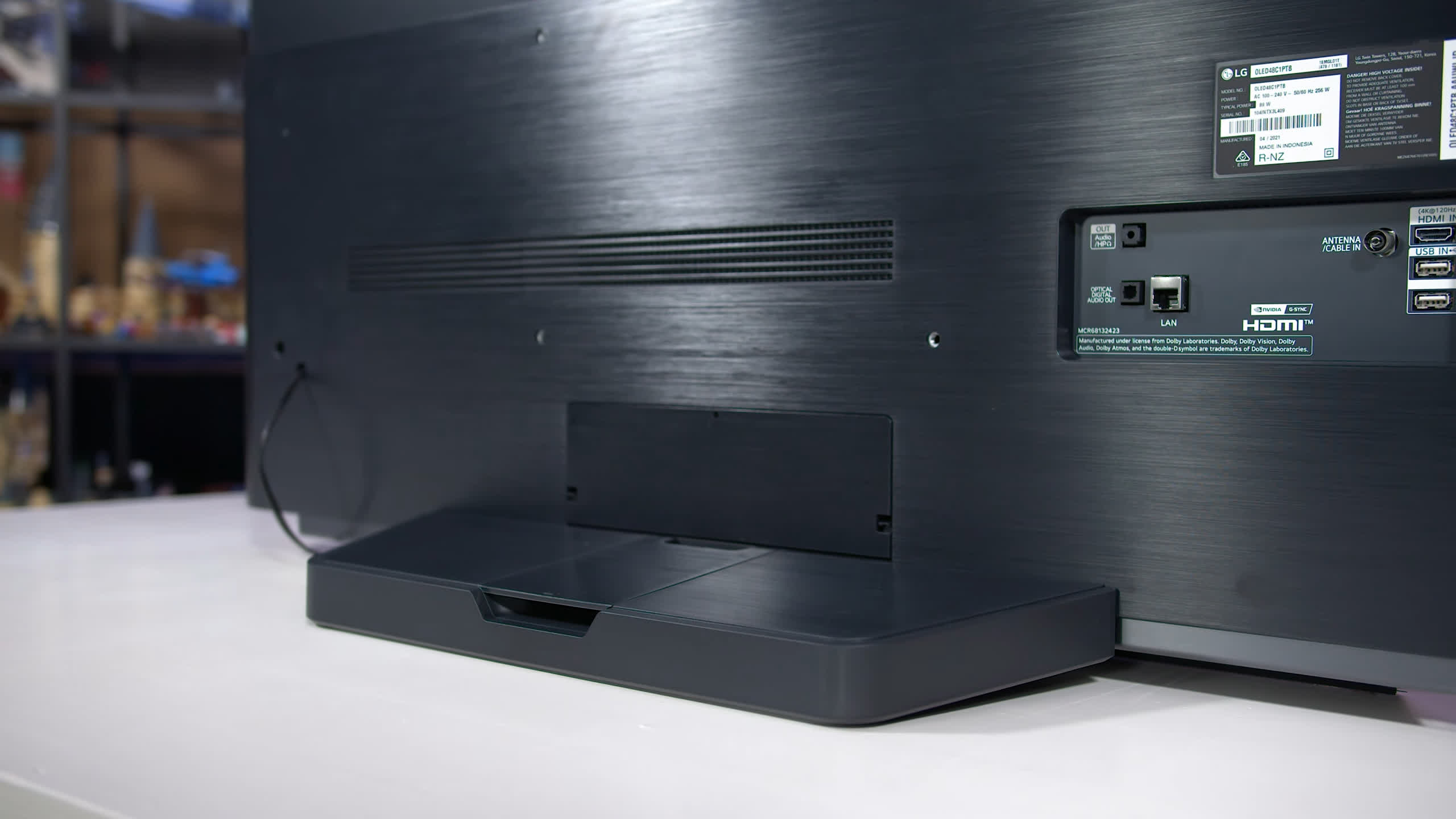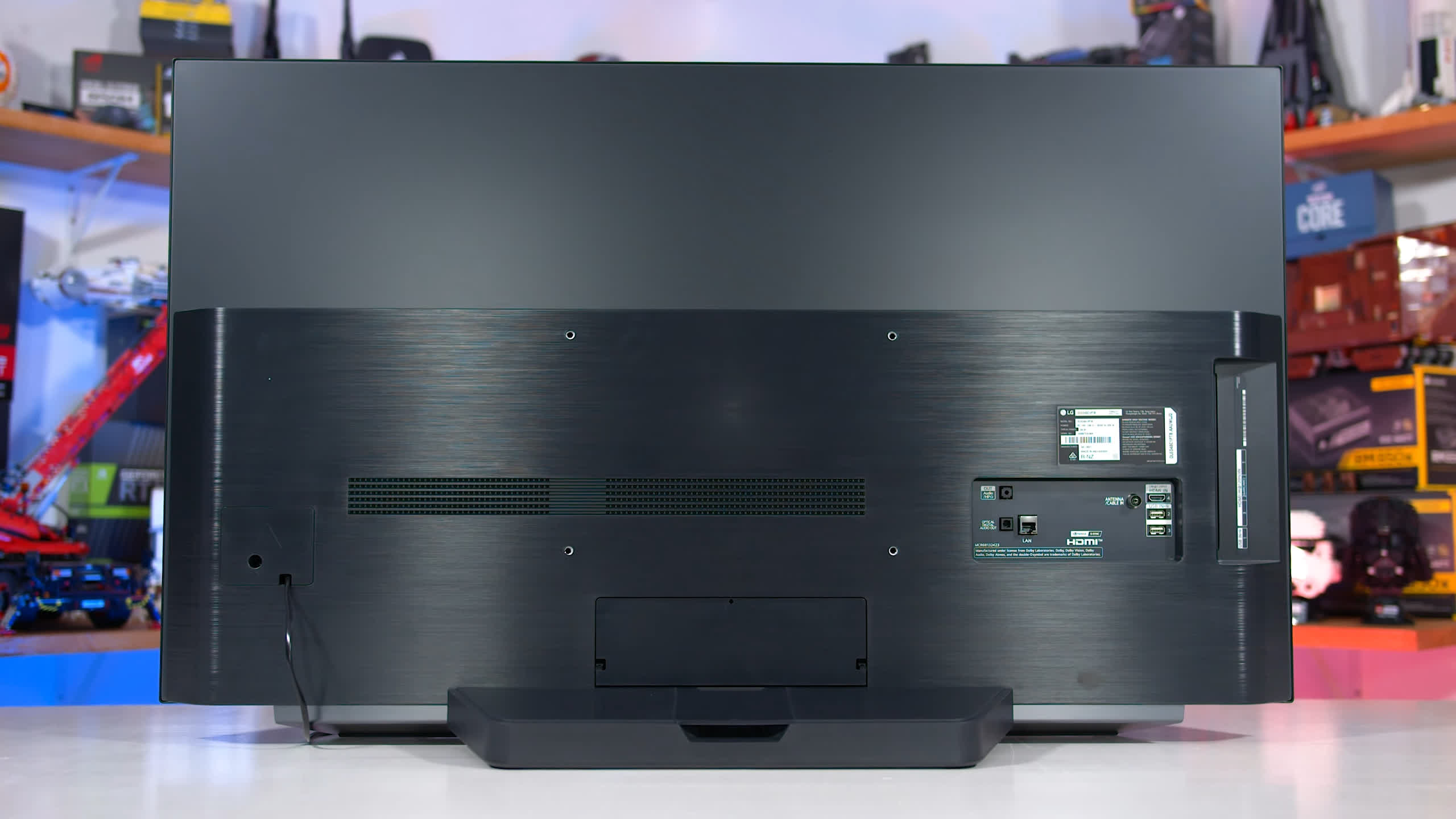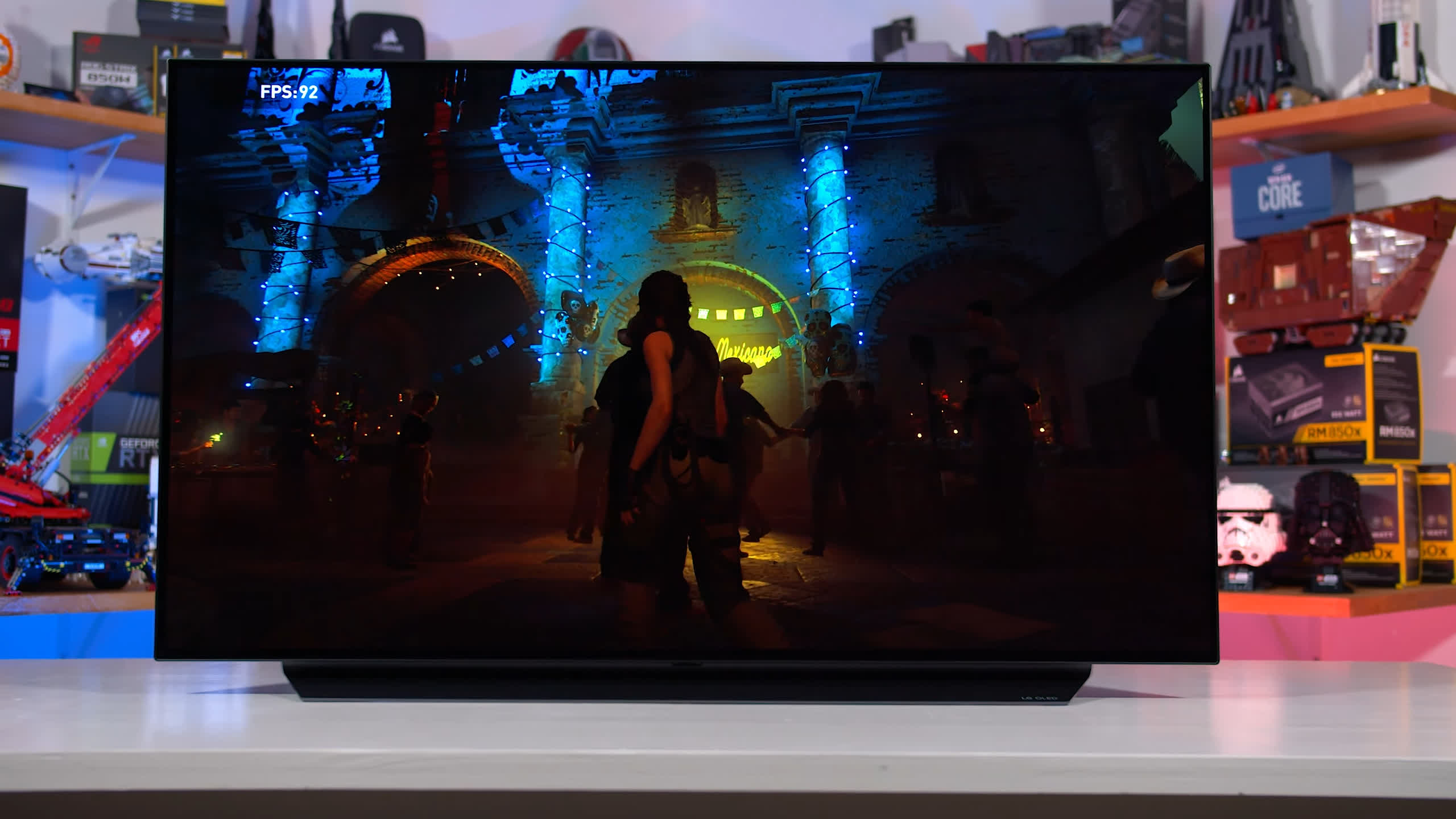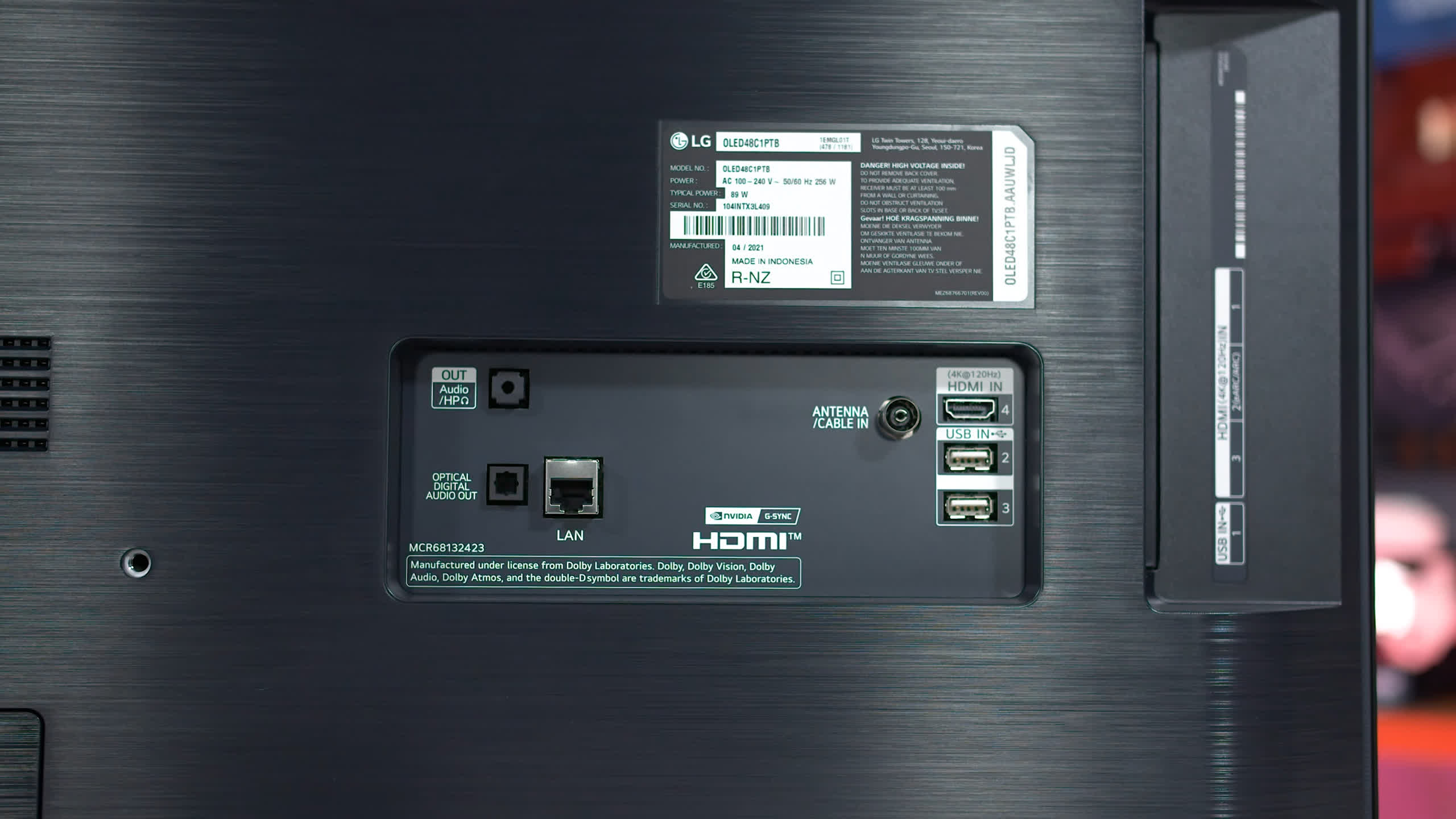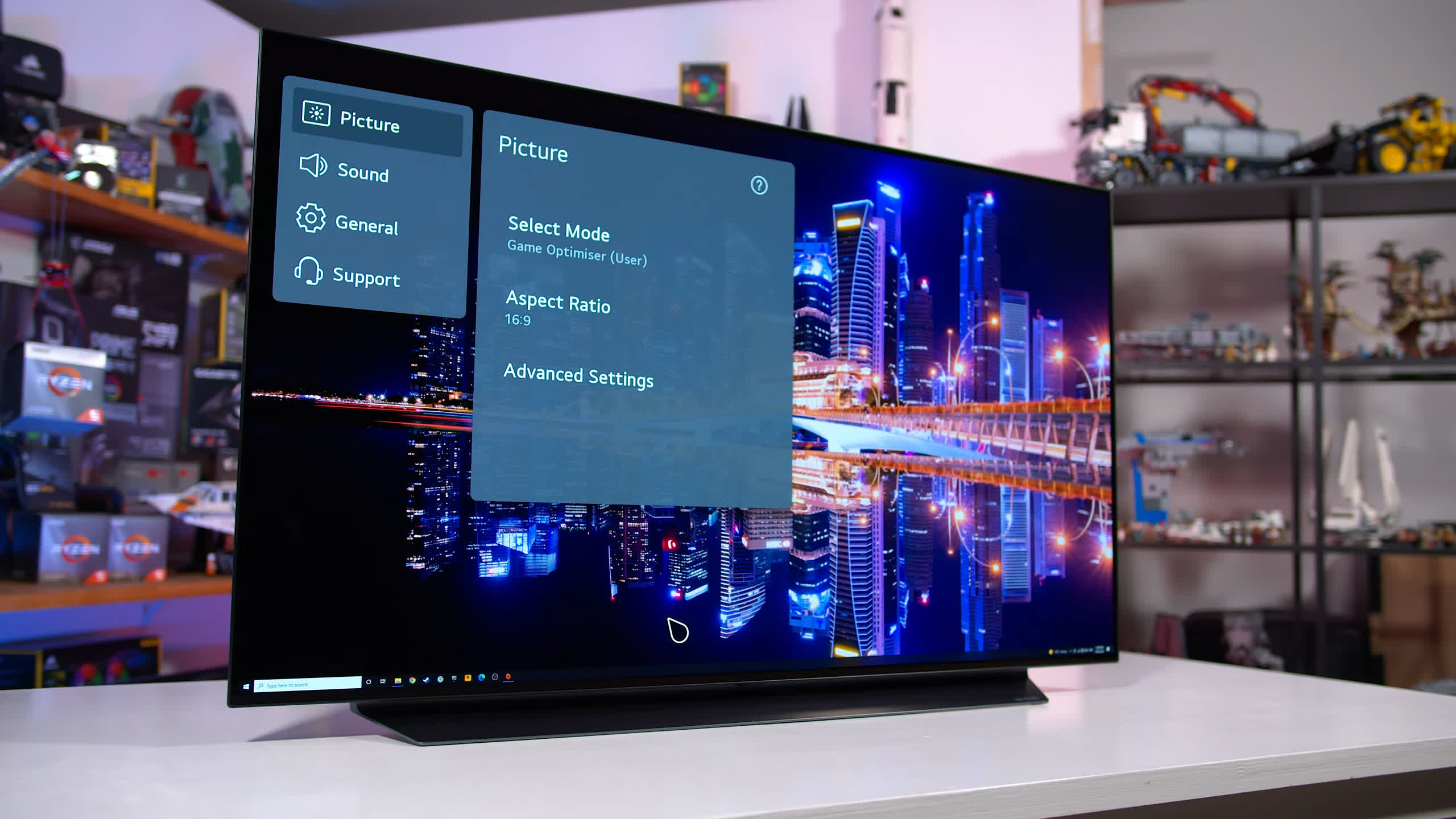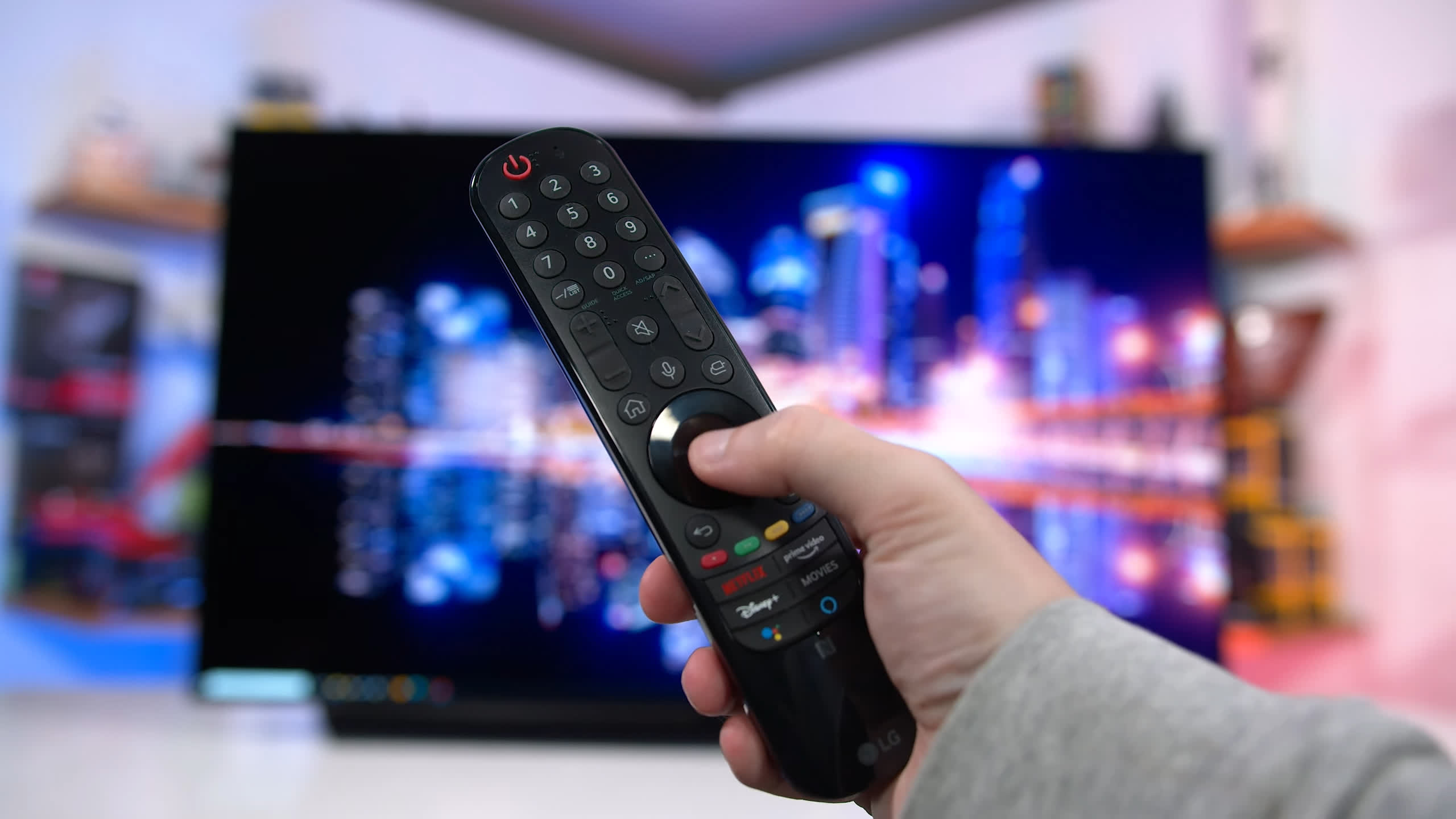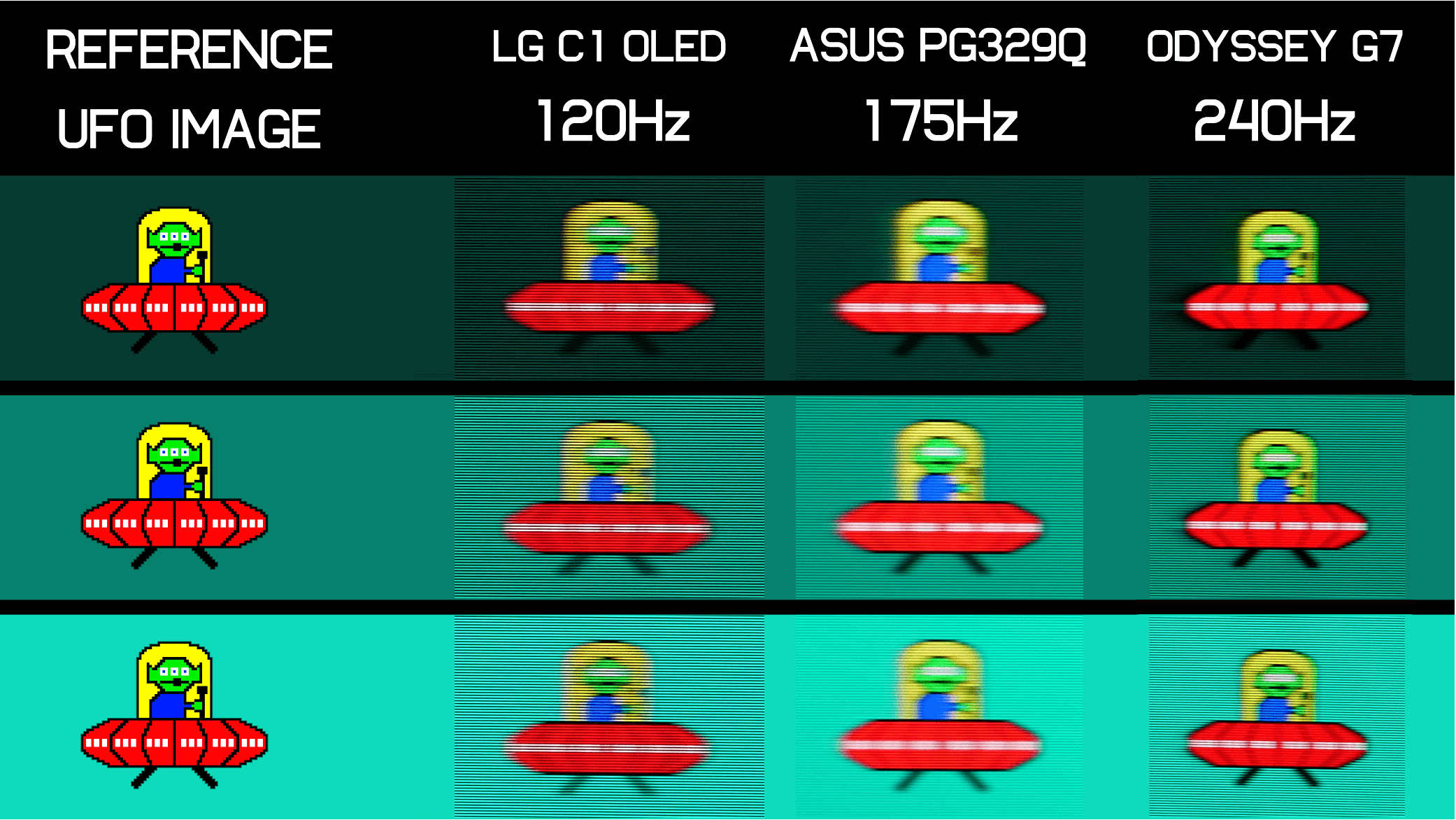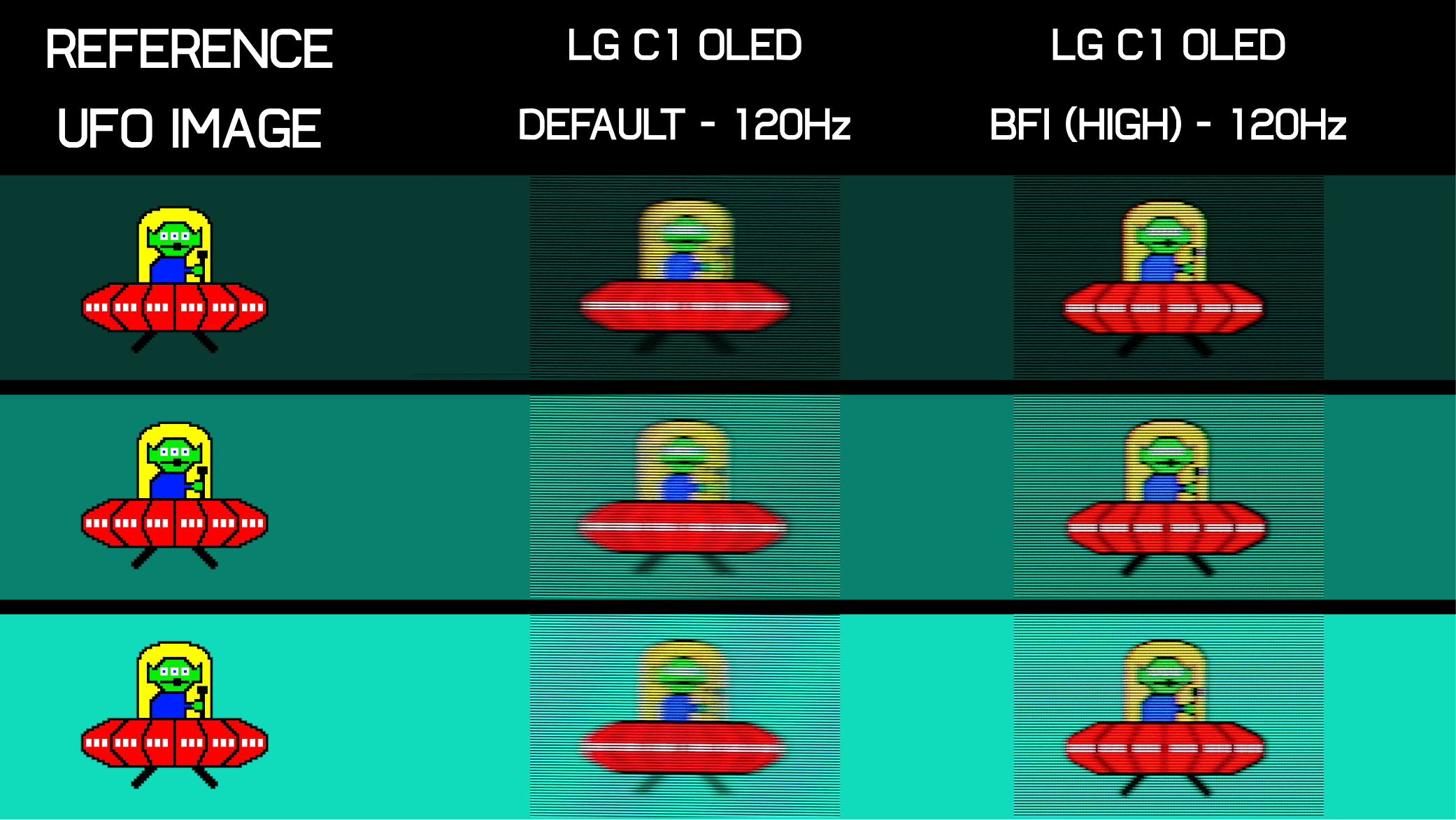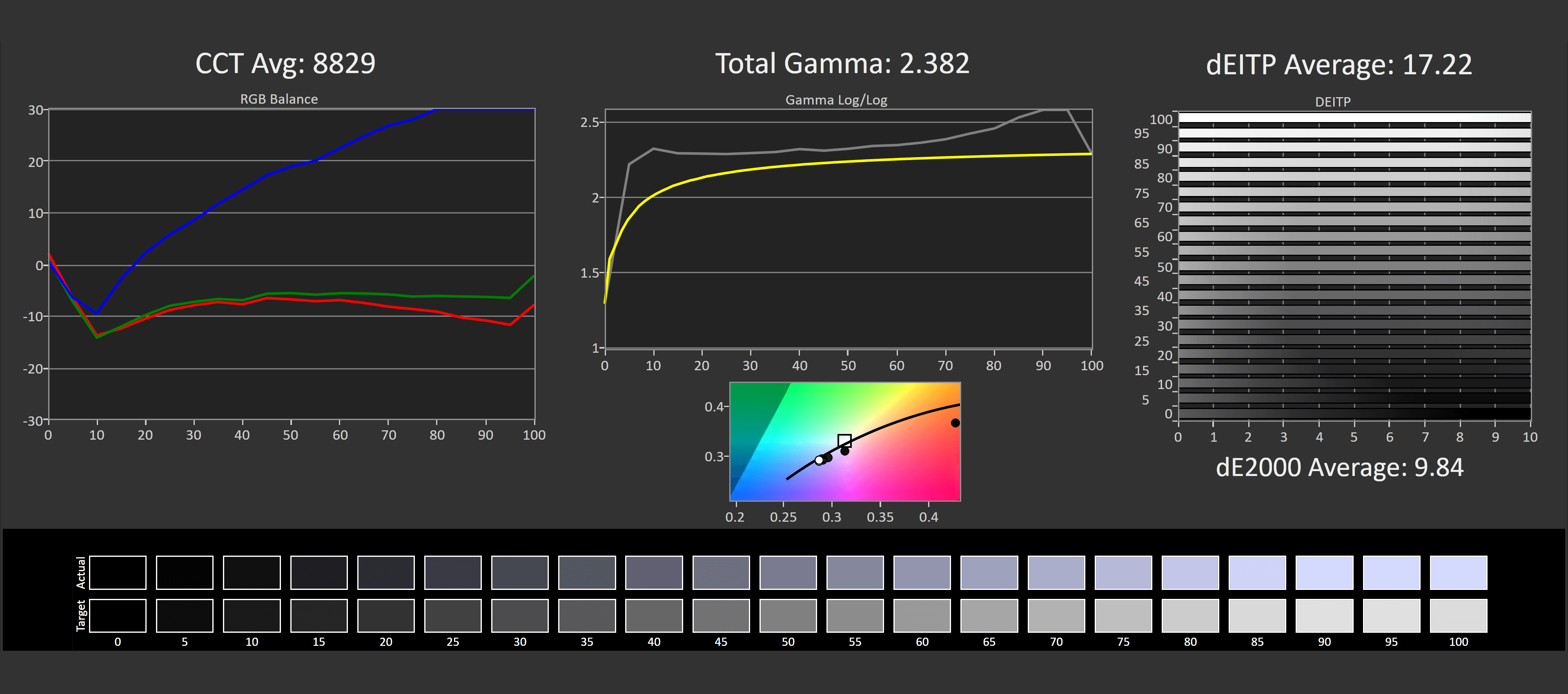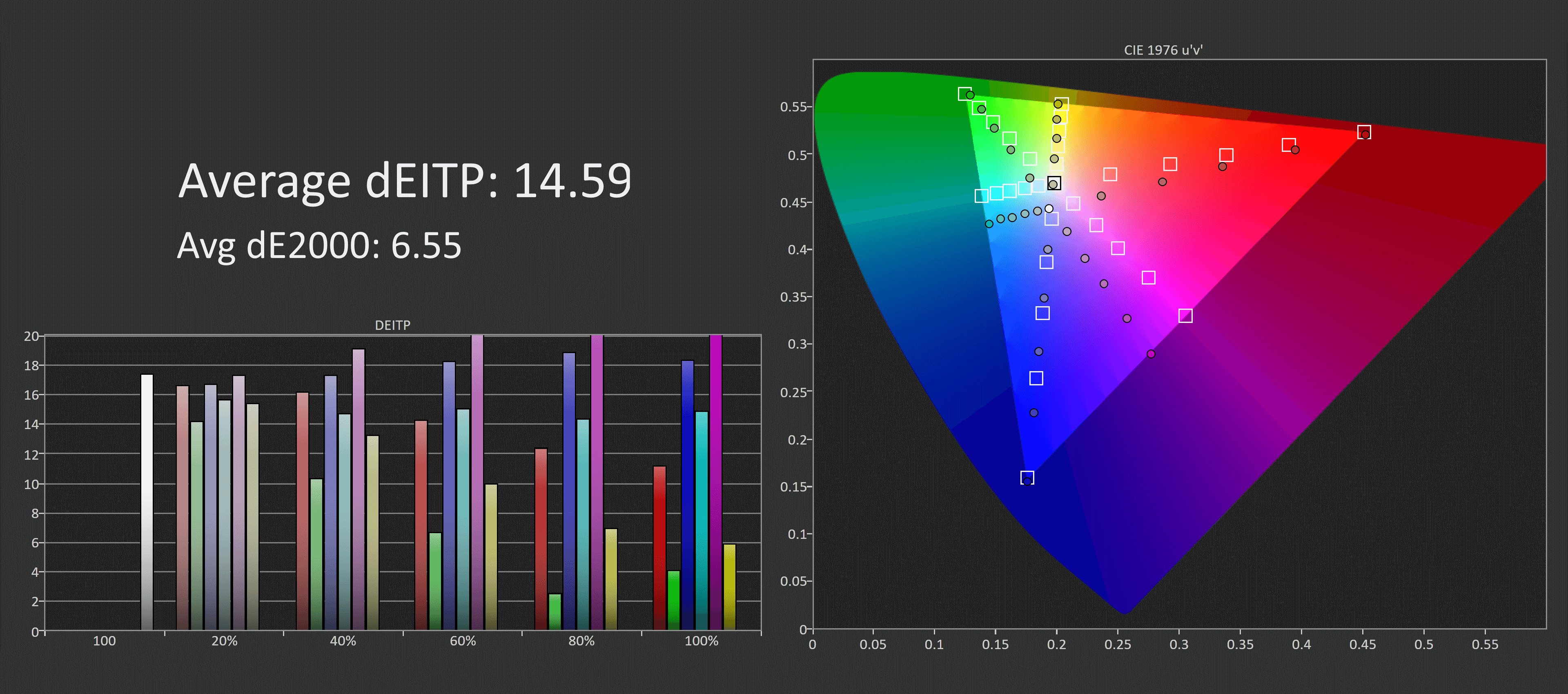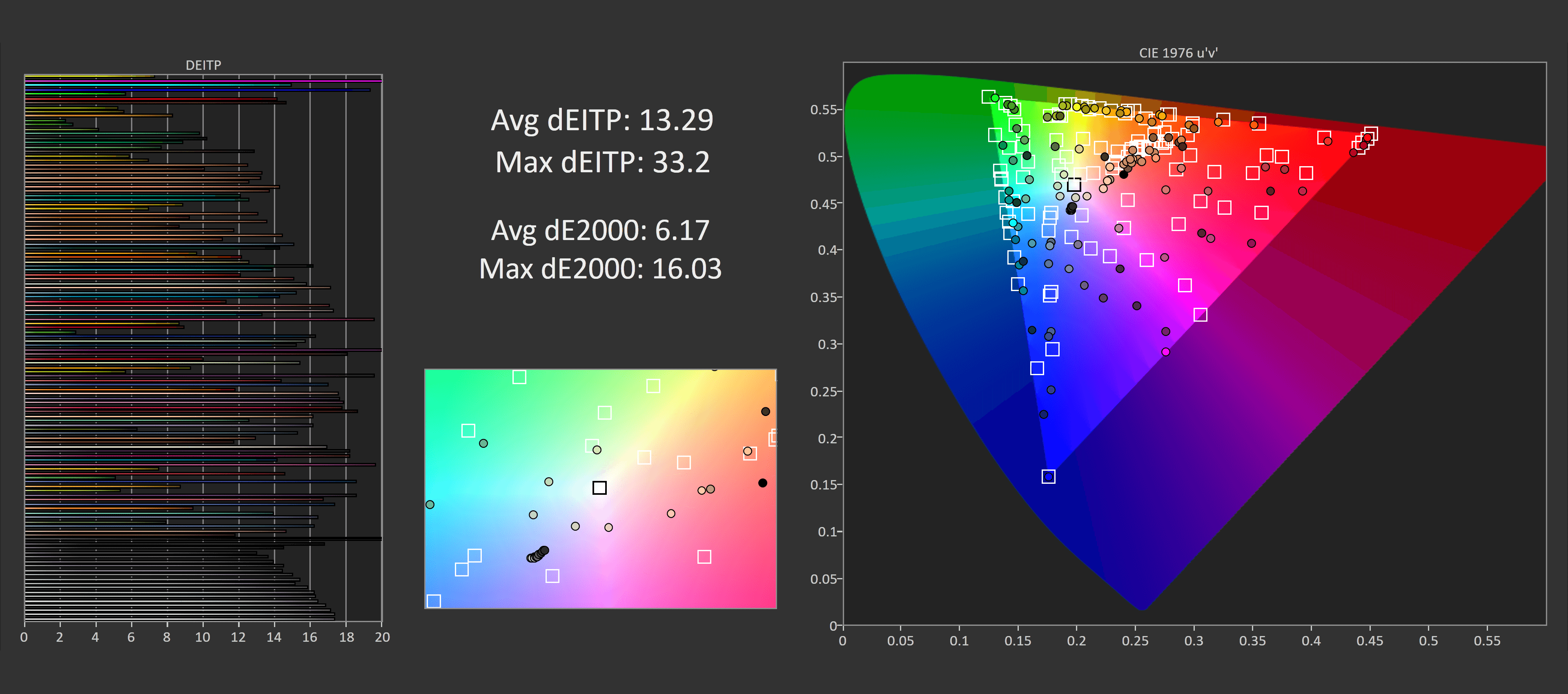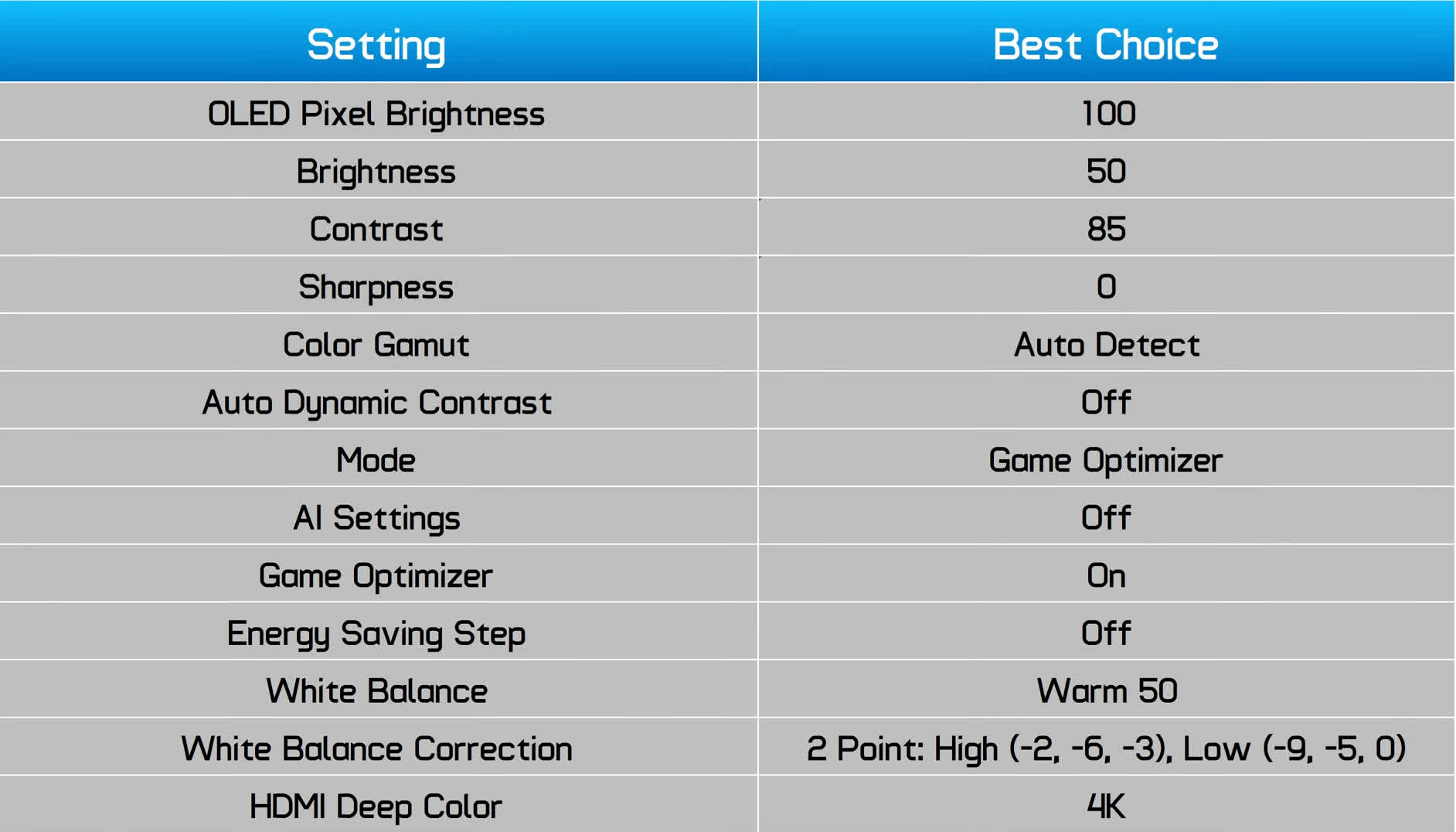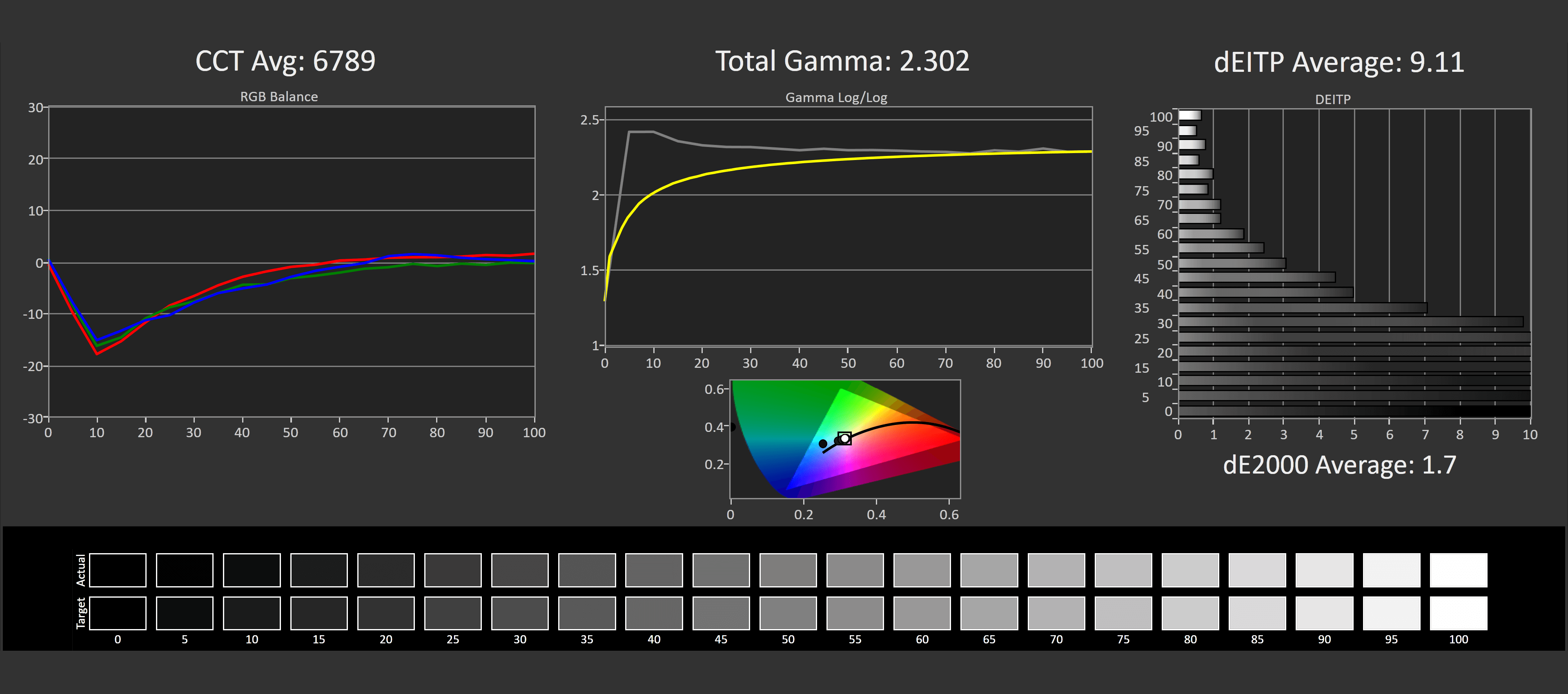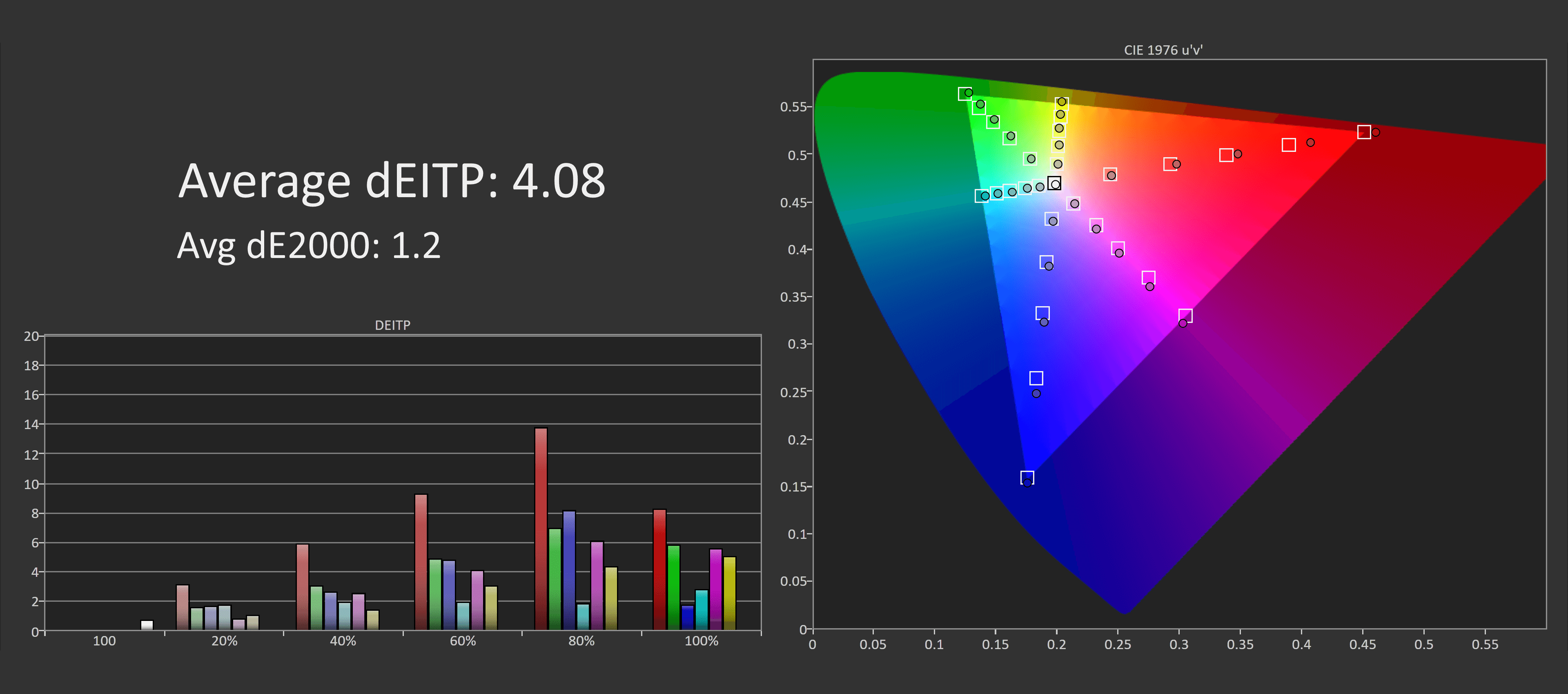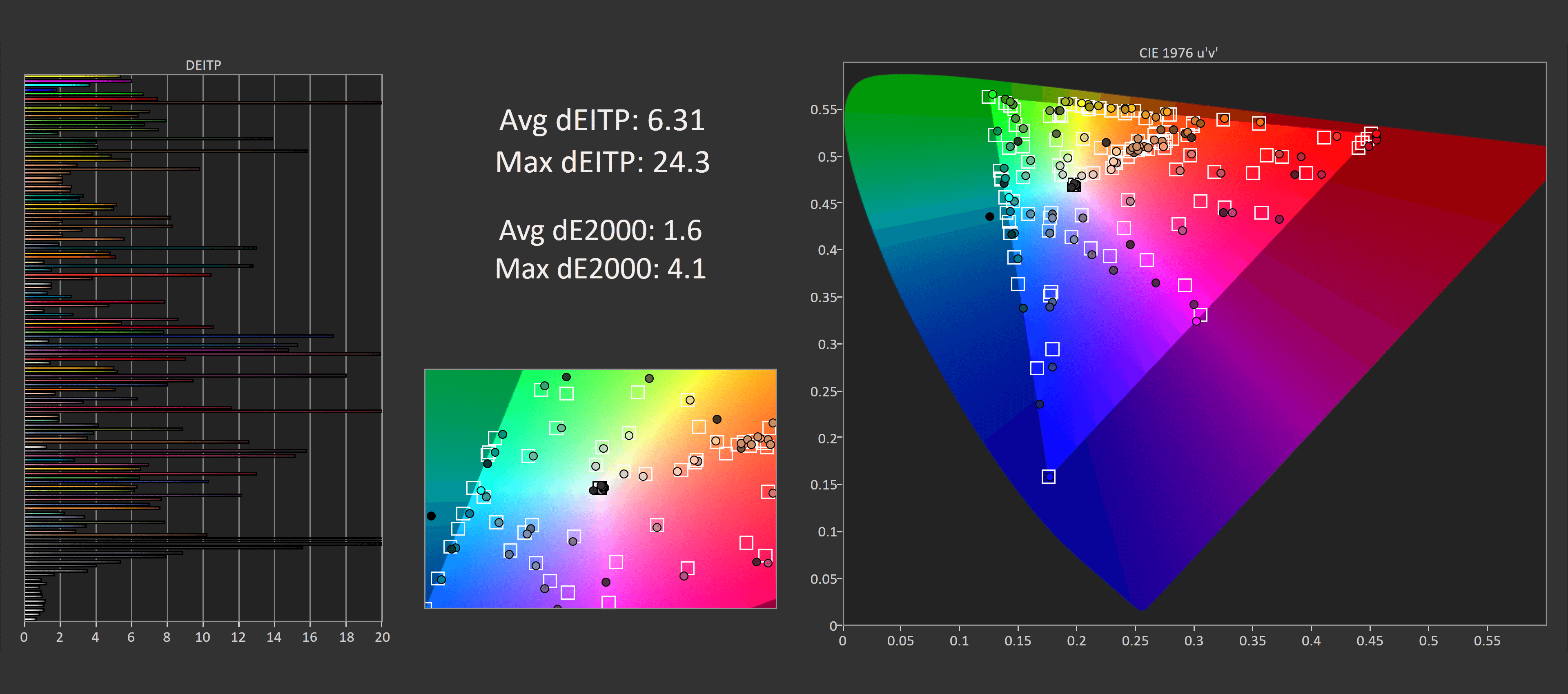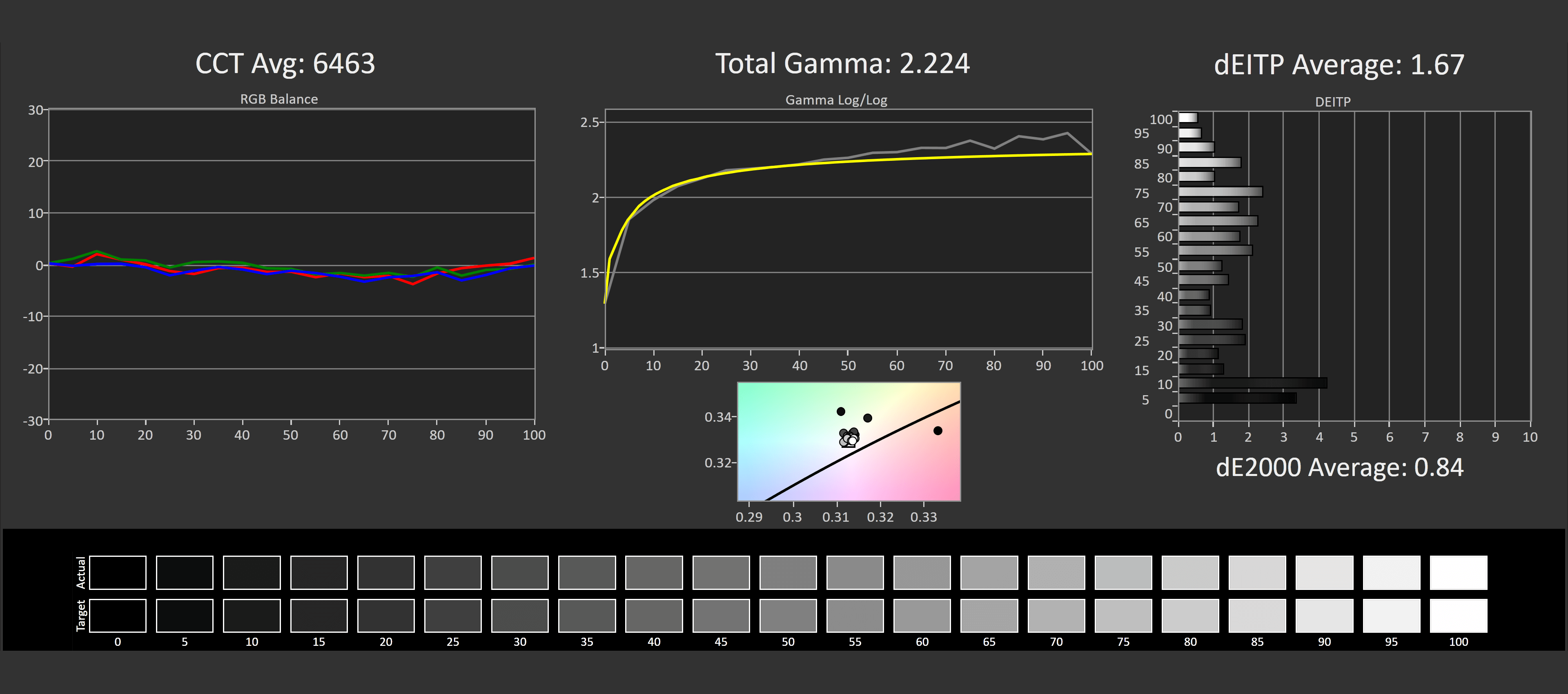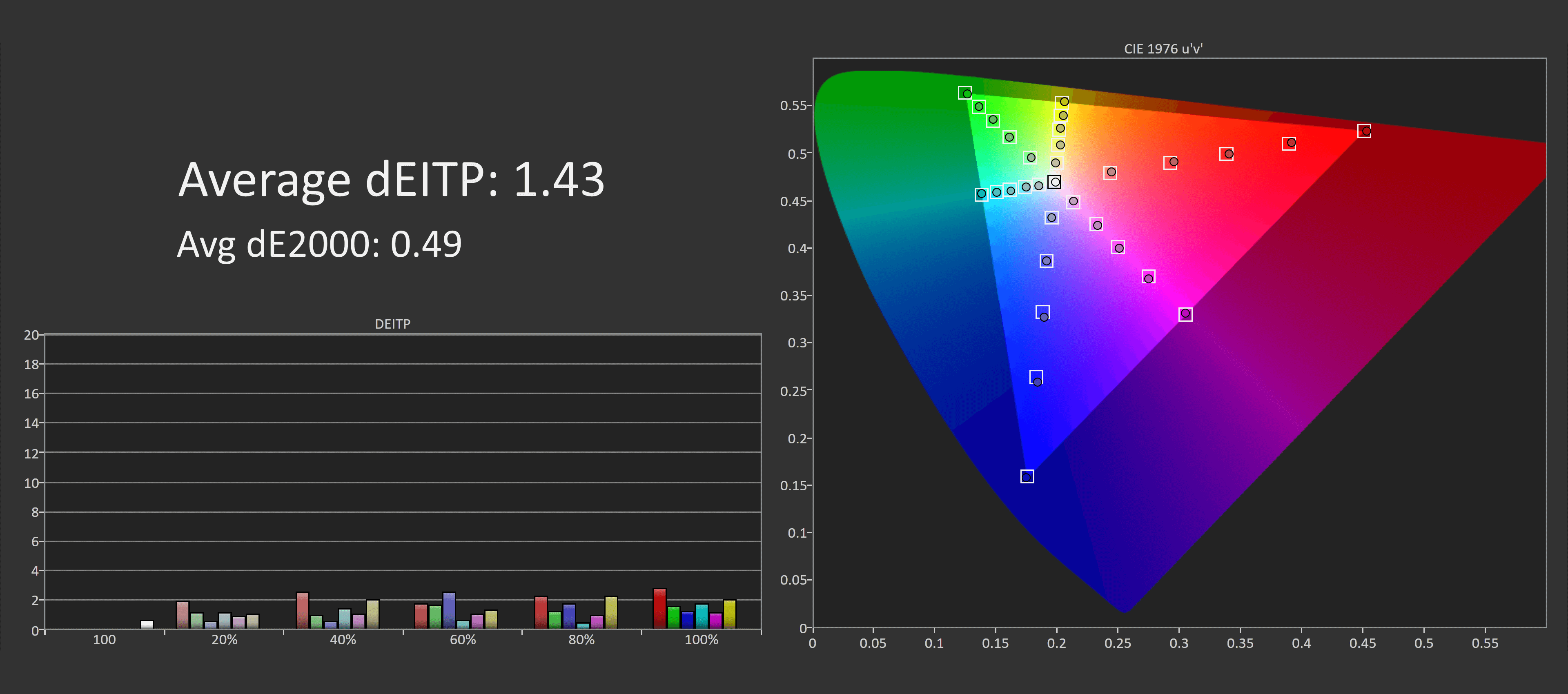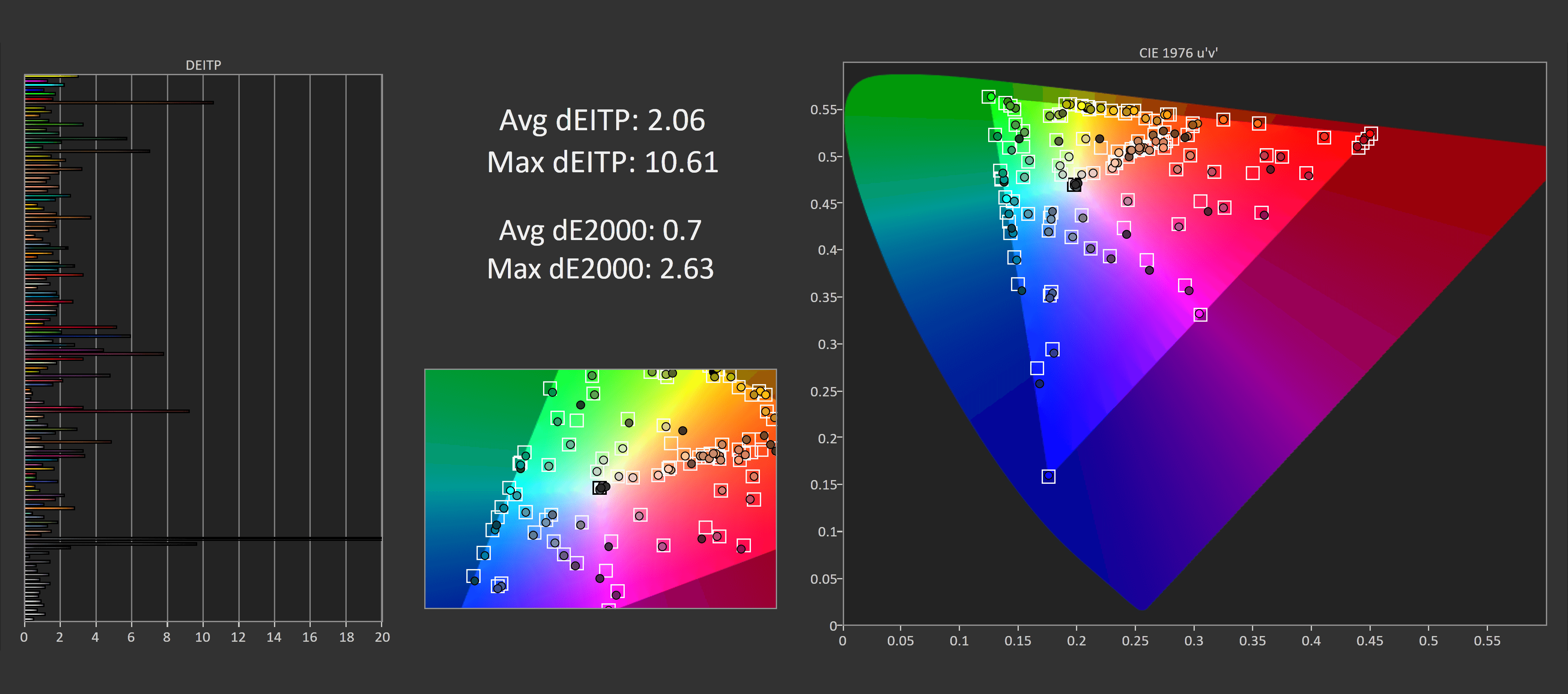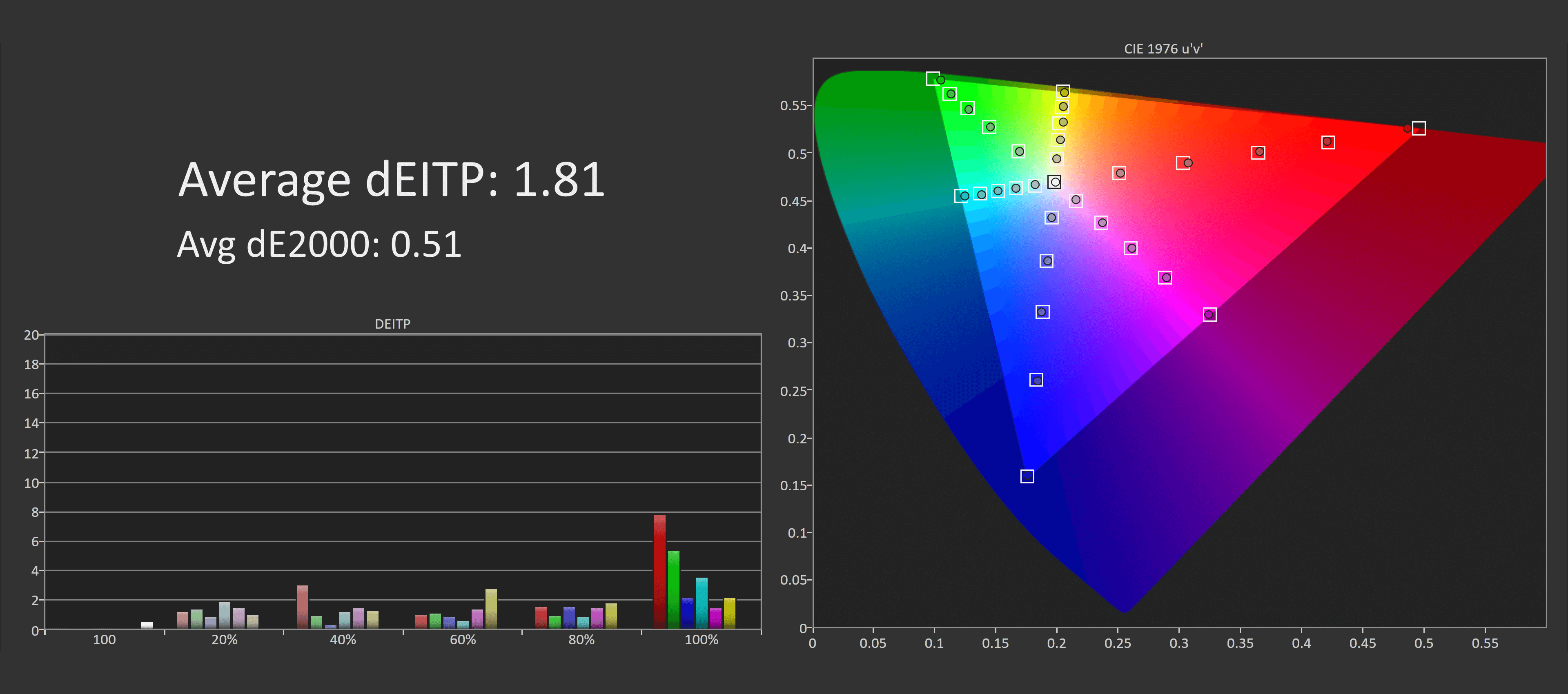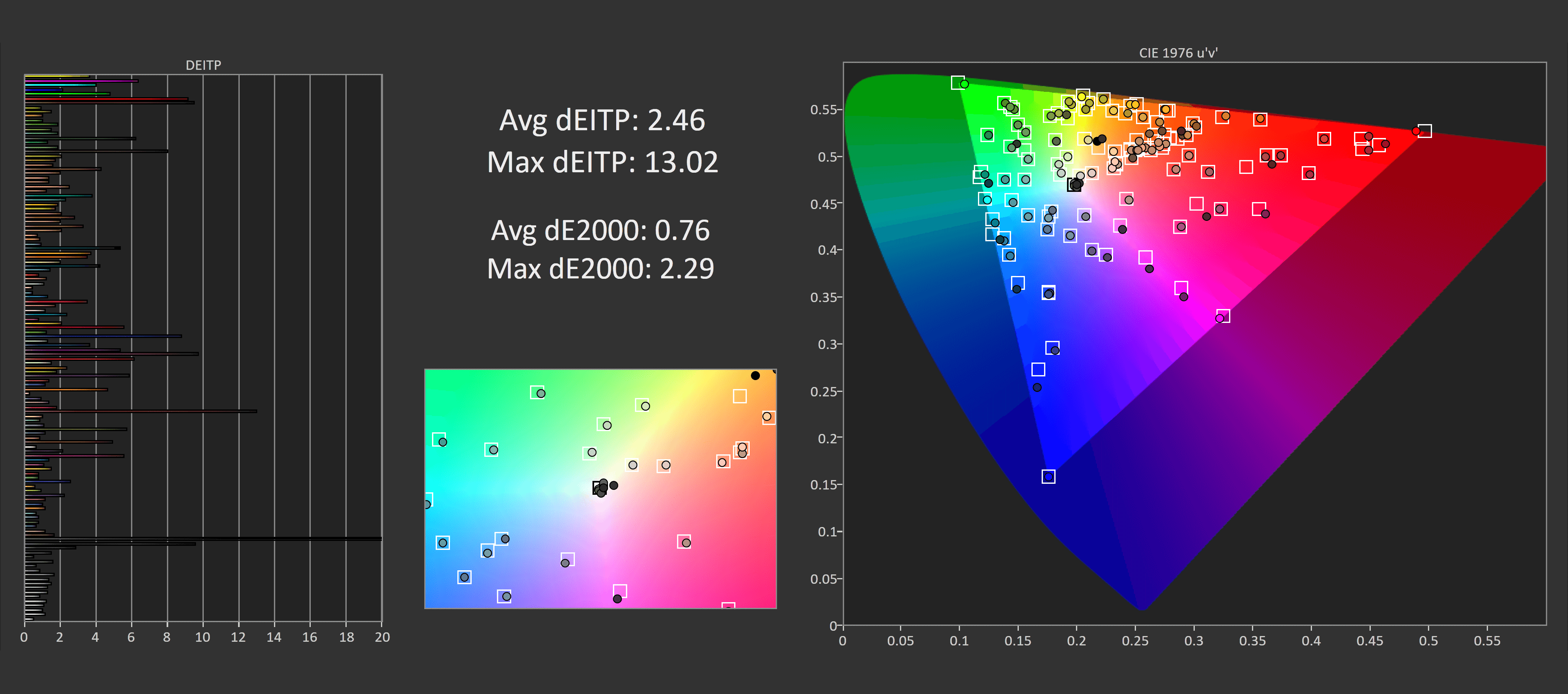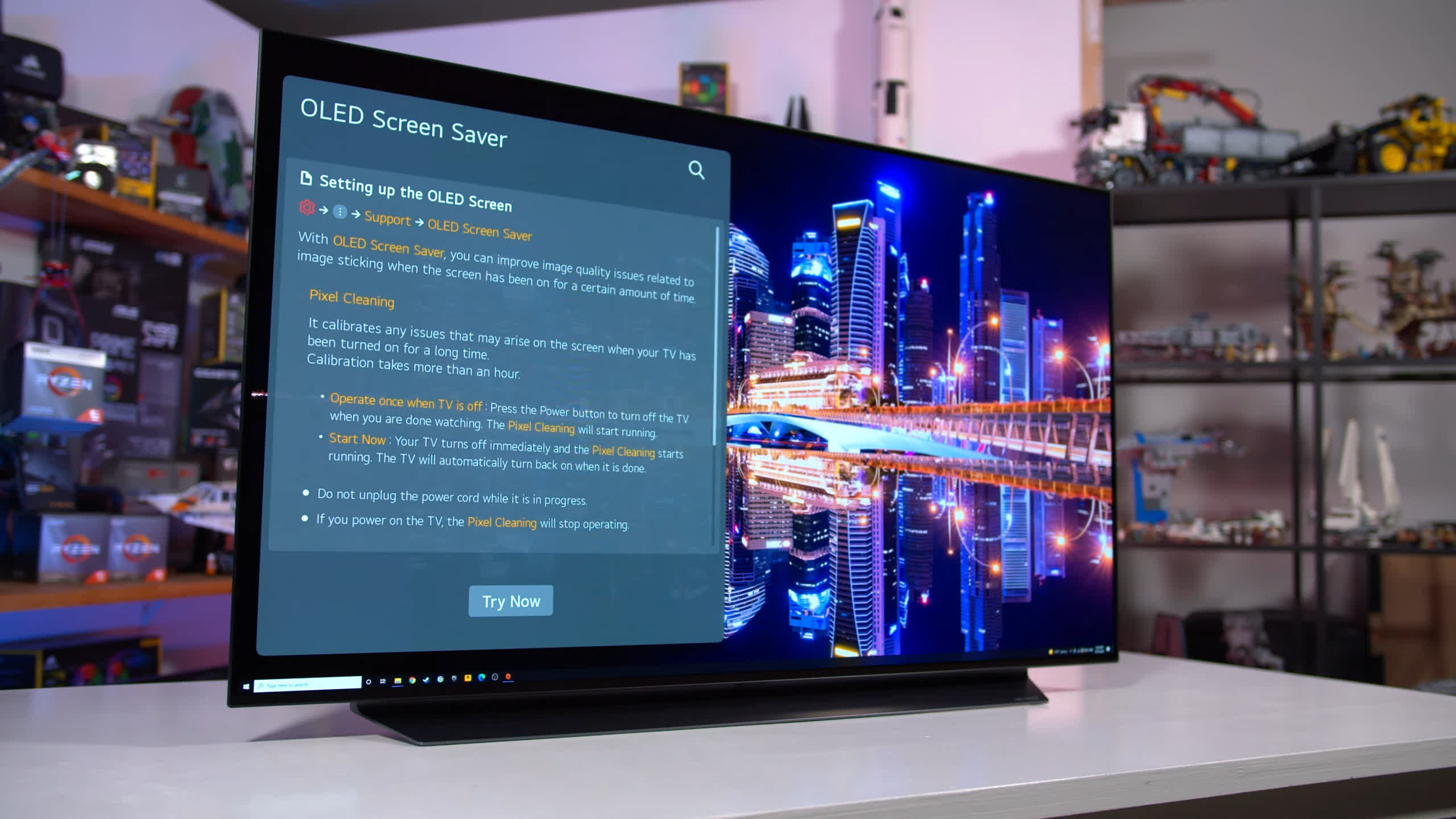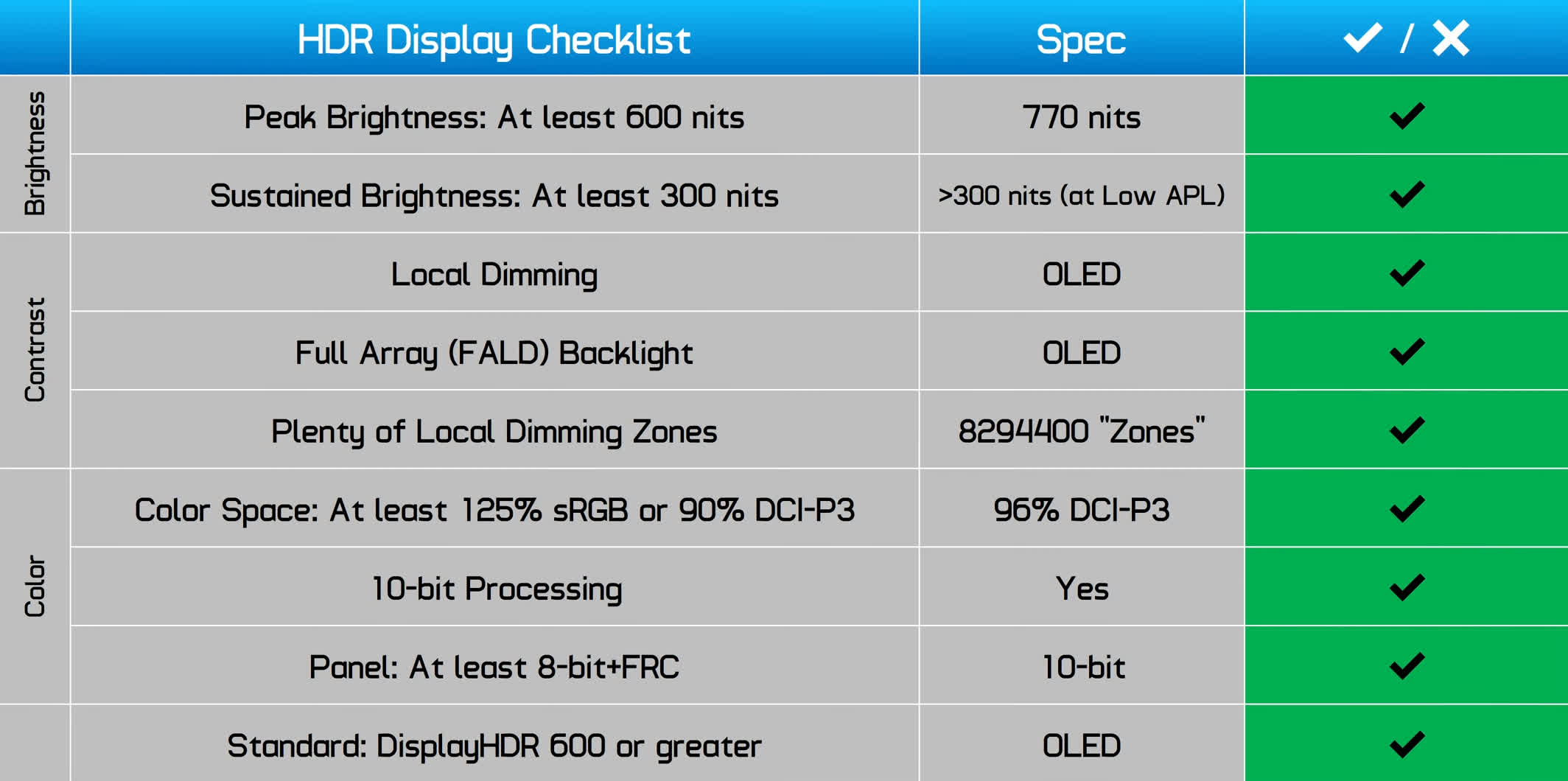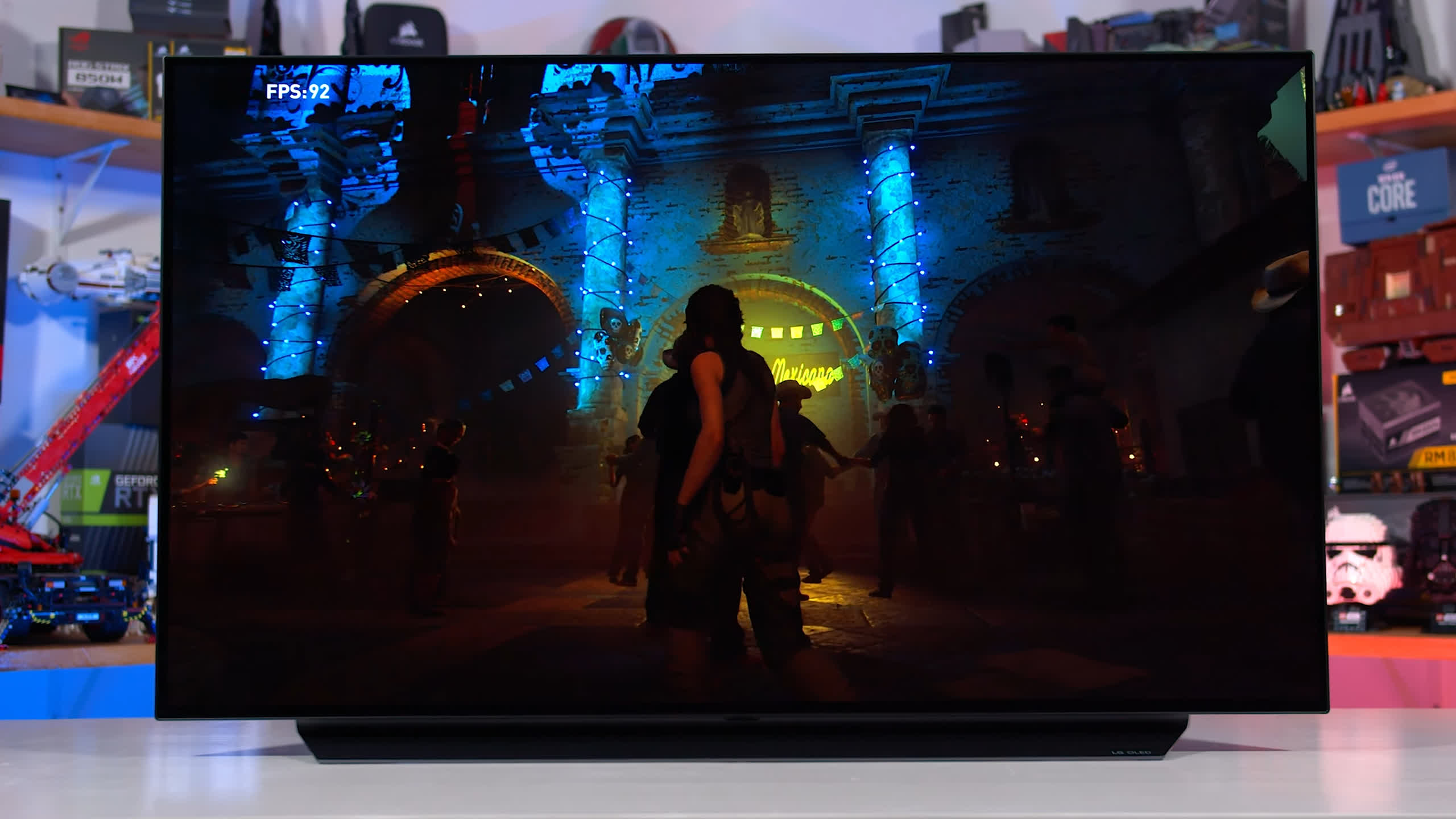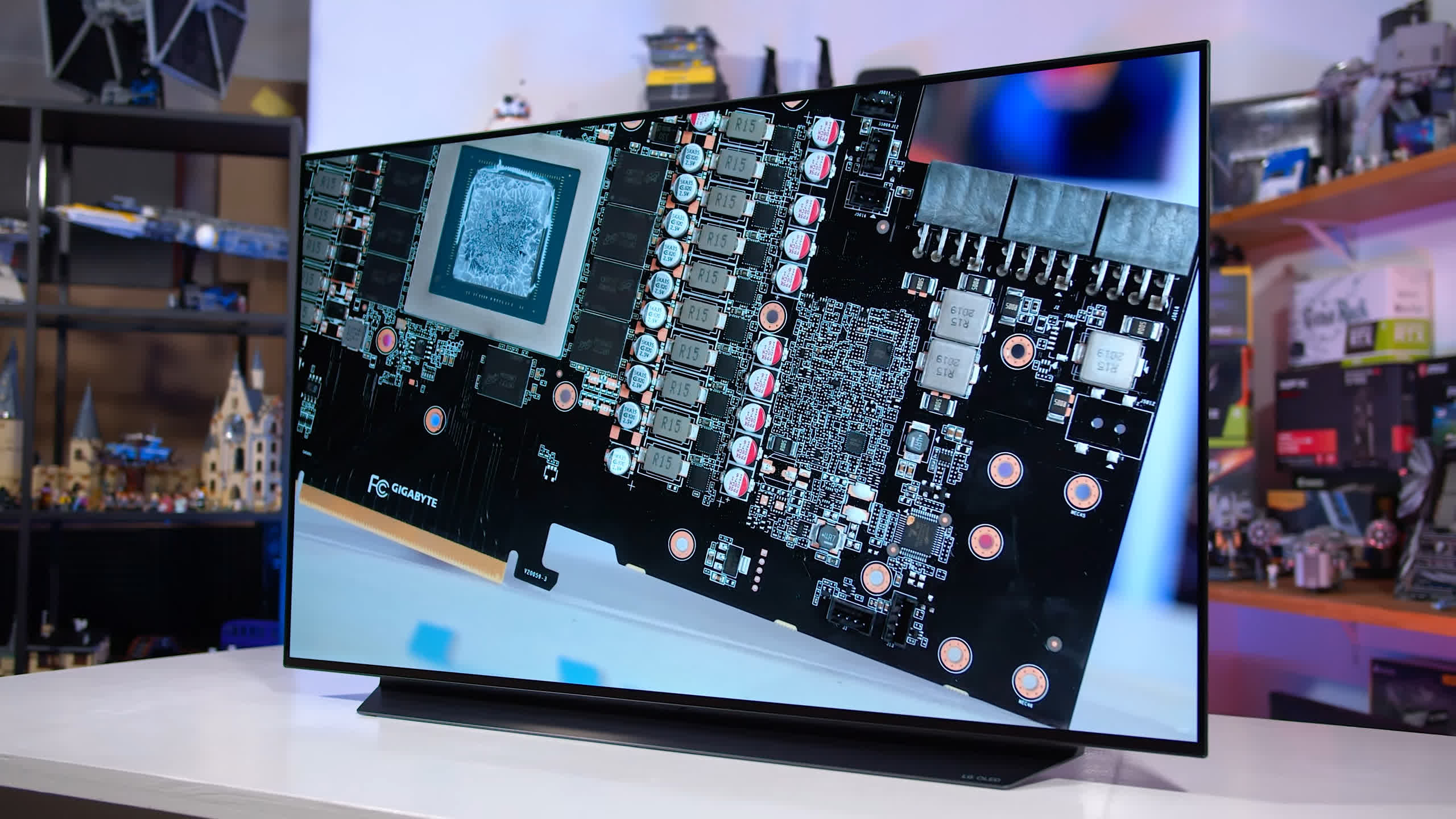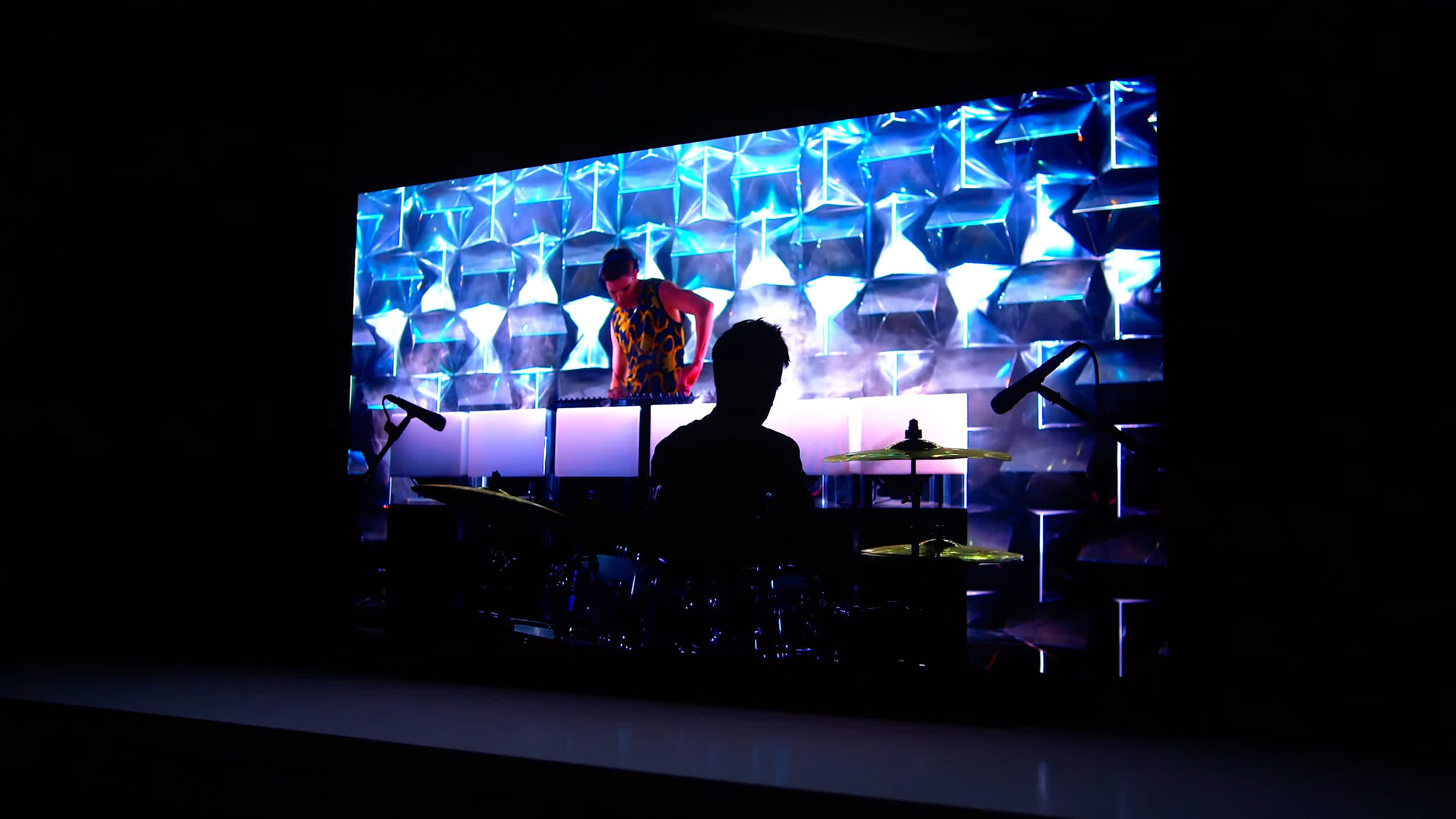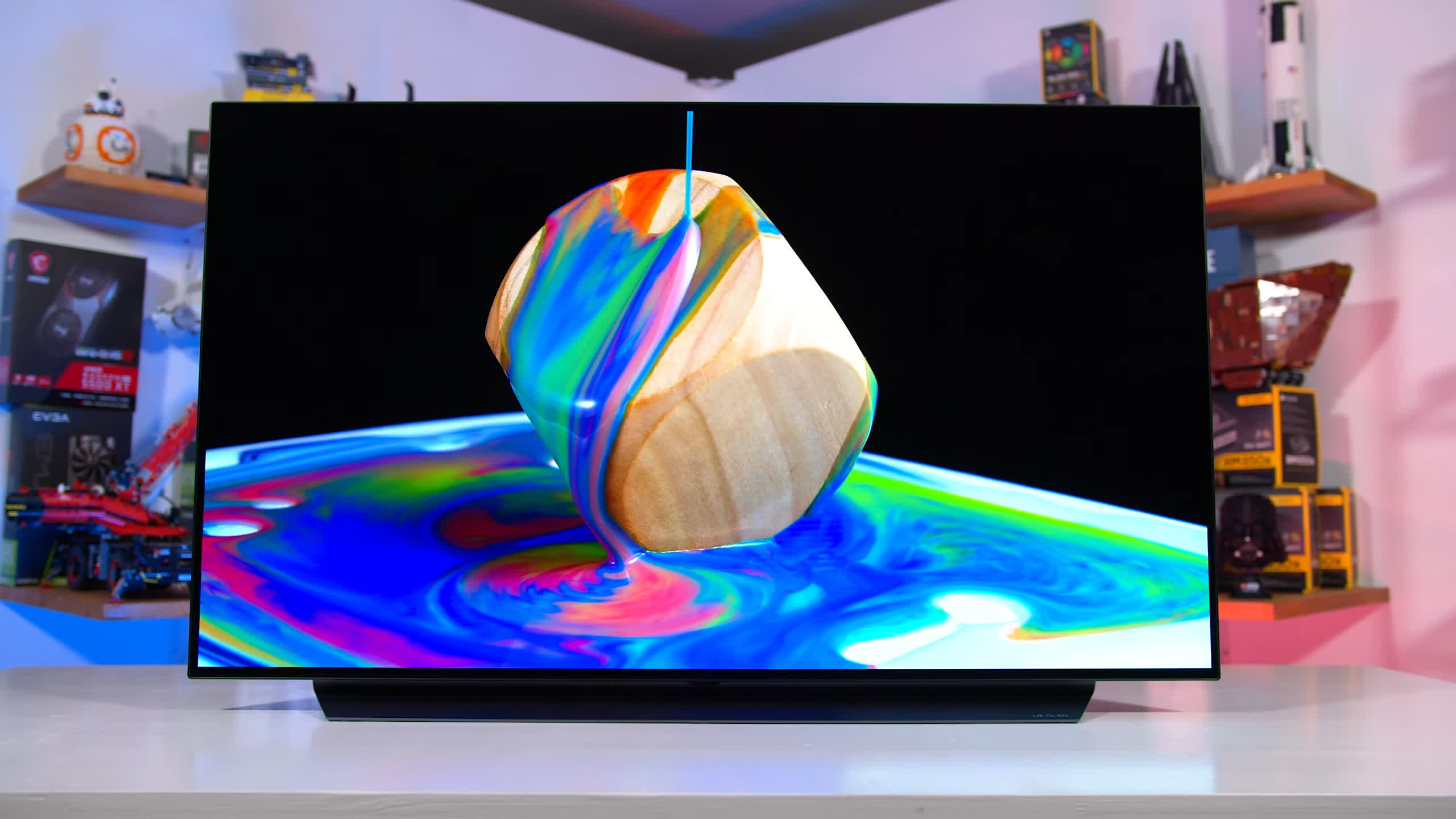Finally! We've long been requested to thoroughly review an OLED display to properly see how it compares to the latest LCD gaming monitors. And at some point we did, just not like this one. I get a ton of questions about OLEDs pretty much weekly, so hopefully this review and the data we've gathered will answer your burning questions and will show how this technology fares in our current monitor test suite.
For today's review, we went out and bought what many people consider the best OLED screen for gaming and the most suitable candidate for usage as a PC monitor: the LG C1 OLED. This is LG's latest OLED TV series designed primarily for content consumption and brilliant HDR, but in the smallest 48-inch option - the one we bought for testing today - it may also be usable as a monitor, that's something we'll have to figure out.
The LG C1 is one of the best OLED displays for gaming because it combines the technology with a 3840 x 2160 resolution and a usable refresh rate of 120 Hz. The vast majority of OLED monitors are designed for professionals, so they are capped to 60Hz and often cost thousands upon thousands of dollars.
That's not the case here: the C1 not only supports a 120 Hz refresh, it also includes both G-Sync and AMD FreeSync support, bringing the variable refresh rate tech we see with virtually every gaming display these days.
It's also not outrageously priced for a high end display, at $1500 and often on sale for below that.
While there are serious gaming specs here, and LG has done a great job of supporting the gaming market with their OLED line, the C1 is still primarily designed to be used as a TV.
It has "smart TV" functionality, so you can run apps directly on the TV itself, a built-in tuner, and lots of image adjusting features like AI processing and all that stuff. It also lacks some of the convenient features we enjoy with most monitors, like DisplayPort connectivity.
In any case we are not reviewing this as a TV, we're assessing this as if it were a monitor you would choose to use with a PC and other input devices.
If you're interested in how this compares as a TV to other TVs, we'd recommend checking out a website like Rtings that will thoroughly assess that for you.
Design
Because this is a TV, the design language is quite different to most monitors we look at. The stand, for example, is basically a strip of metal that runs along the bottom edge of the display, connecting very low down to the display itself.
There is no adjustability whatsoever, you can't even tilt the display into the position you may want, so forget height adjustment or anything of the sort. LG expects you to either use this as is, or wall mount it, and honestly using it with the included stand isn't too bad given its size, I don't really miss height or tilt adjustability.
Aside from the lack of ergonomics, this is a beautifully designed product, built to emphasize the large display in all its glory with slim bezels and an even slimmer depth for the top section.
While this area is ridiculously thin, there is still a chunkier section at the base that houses all the electronics and ports, which uses a more utility focused design rather than something elegant. The exterior materials are also premium, with a mixture of metal, glass, and good quality plastic.
One of the big differences between the C1 and most monitors is the finish used on the display.
The C1 is a glossy glass display, which tends to make colors pop and increase the clarity and crispness of the image. In contrast, most monitors use a matte anti-glare finish, which diffuses the light to some degree to cut down on reflections in bright environments, with modern anti-glare coatings still providing excellent clarity.
What this means in practical use cases is that the LG C1 has increased clarity and "wow" factor in darker environments, but tends to be a lot more reflective than a monitor with an anti-glare coating.
Among TVs, the C1 is one of the better displays at reducing direct reflections with its treatment of the glossy finish, however ultimately you will see much more clear and defined reflections in a well lit room than you would from a normal monitor, most of which only reflect general light rather than defined mirror-like reflections. How annoying this will be will depend on your setup and tolerance for reflections, I personally found it somewhat irritating in my office, but not a deal breaker and often it's not that noticeable when focusing on the content being displayed.
On Your Desk
The other major consideration when buying the LG C1 48-inch is size.
48-inches is far larger than most monitors, and that's something you need to factor in. First, you'll need a large desk, the unit overall is 107cm wide and the stand is 84cm wide, so you'll need to make sure it fits. But then on top of that, the actual screen itself is about 105cm wide and 60cm tall, which is massive for desk usage.
In comparison, a standard 32-inch display is only 70cm wide and a 34-inch ultrawide only 80cm wide, so this 48-inch TV is 25cm wider than an ultrawide in addition to being significantly taller.
Pixel density is not an issue - 48-inch 4K is the same density as 32-inch 1440p - so the C1 is usable with 100% scaling. It's just so wide that the entire screen may not fit in your field of view with standard desk viewing distances. I normally sit about 60 to 70 cm away from my 34-inch ultrawide (about an arm's length) when gaming, but found that distance uncomfortably close with the C1. I needed to be more like 1 meter away or greater.
This presents some problems for desktop usage as you'll need a deep desk or to figure out something custom to have the C1 and your keyboard/mouse on the same surface. I actually think this is one of those rare cases where the C1 should be curved for closer viewing distances, similar to most gaming ultrawides, just so the edges are better and more clearly in your field of view. Obviously, this wouldn't work well for a TV that most people view from a reasonable distance, which is why LG has kept it flat.
So we've already found a few challenges with using the C1 as a monitor: the glossy finish, and its size. But there's another important factor as well, and that is text clarity. The C1 uses LG's WRGB subpixel layout, meaning that in addition to the normal red green and blue subpixels for each pixel, LG are also including a white subpixel to improve brightness and other aspects to display quality. However, in the modern world of subpixel text rendering, any time the pixel structure differs from RGB, text clarity tends to suffer to some degree.
I still found the C1 to produce generally great text, but it was inferior to the IPS displays I use daily. The Windows ClearType utility can help fix this to some degree. WRGB is not nearly as bad as BGR for clarity, but it's still something to keep in mind.
For ports, the C1 includes four HDMI 2.1 ports in addition to several other ports, including three USB, both analog and optical audio output, Ethernet, and an antenna input for the tuner. The key thing to talk about here is HDMI 2.1, as this facilitates up to 10-bit 3840x2160 resolutions at 120Hz. However it's also the only way to access this refresh rate, meaning you'll need a modern graphics card (either from Nvidia's RTX 30 series or AMD's RX 6000 series or newer) to get the most out of the C1.
Older GPUs with only HDMI 2.0 support will be limited to 60Hz using full RGB, so for monitor usage it would have been nice to see DisplayPort with DSC, however this was never going to happen on a TV focused product.
Impressively though, despite being an HDMI only display, I had no issues with variable refresh rate support on either AMD or Nvidia GPUs as both technologies are supported. With HDMI 2.1 included here, there are no issues using this display with the latest game consoles without limitations either.
Looking at the OSD, it's a TV, so there's a complex array of menus including smart TV features and a wealth of settings. However I'm going to ignore the vast majority of smart functionality (which may or may not come handy to you) as we're mostly interested on how the C1 performs when it's hooked up as a monitor. You don't even have to connect it to the internet if you don't want to, although I'd advise you do, so you can receive firmware updates.
The OSD is controlled through the remote control which uses a combination of buttons and a wand like pointer control. The menu is easy to navigate but naturally has lots of things to adjust, and there is a setup process that will guide you through a lot of it.
Outside of that, I'd recommend making sure HDMI Deep Color is set to "4K" in the HDMI settings, and that the Game Optimizer mode is used so that variable refresh rates are enabled, 120Hz is accessible and input lag is reduced. You won't find things like cheat crosshairs in this TV, but you will still find blue light filters and we'll talk more about optimized settings later.
Display Performance
So far we have already dived into some of the challenges of using the LG C1 as a monitor but make no mistake, as we begin talking about image quality you'll quickly see why people want to use this display as a monitor. And we'll start here with response times, noting that the C1 does not have any overdrive controls.
Being a self-lit OLED panel, response times are incredible at 120Hz. This is what I would describe as a true 1ms display, it's not a situation where LG advertises 1ms and then kinda cheats to get that figure using ridiculous overdrive settings that badly hurt image quality. No, this is what a real 1ms display looks like. On average, straight out of the box, the C1 can hit a 1.3ms response time average with no overshoot, even with our stringent and updated response time testing methodology for 2021.
When you combine the response time and overshoot results, it's no surprise that the C1 gets very close to producing instant response times, as illustrated by a double-digit cumulative deviation average (normally this is in the mid triple digits for LCD based monitors).
Now, I wouldn't necessarily describe the panel as having "instant" transitions as there is a slight curve to the response, but it's as instant as we can get with modern display technologies. LG is not even bending the truth when they say the C1 has a "1ms" response time, it absolutely 100% does on average even after gamma correction and when measuring 97% of the response curve.
This helps deliver excellent motion clarity, with the only blur you'll see in motion attributable to the modest 120Hz refresh rate. With a sample and hold display like this, 120Hz isn't fast enough to deliver a completely clear image in motion as you'll see from this UFO test - a 240Hz display with worse response times will generally have better overall clarity as the image is updated twice as often. But this is the best 120Hz experience we've got, and of course 240Hz is not achievable on any current 4K display, so the C1 gives elite motion clarity among the 4K displays of today.
On top of producing outrageous response times at 120Hz, the C1 does an excellent job of holding that performance throughout the entire refresh range. I tested at 100Hz, 85Hz and 60Hz as well, noting no significant change to performance at any of these refresh rates. There is a very small reduction to performance at lower refreshes, but this is hardly significant at all. This means a perfect experience while gaming with a variable refresh rate.


The LG C1 humiliates LCD-based monitors in the response times it can produce. Even the fastest monitors I've tested like the Samsung Odyssey G7 and HP Omen X 27 don't come close to what the C1 is able to achieve.
When viewing average performance across the refresh range, the C1 is in the ballpark of three times better than the next best product, with lower overshoot to boot. This is an incredible result that puts LCD panels to shame.

The most striking graph you'll see illustrating the motion clarity benefits of an OLED panel is the cumulative deviation chart. LCDs simply do not get close to OLEDs in how they can replicate the ideal instant response. The C1 OLED actually gets quite close to an instant response, while none of the LCDs do. We're looking at results in the range of 7 to 10 times better than a modern high performance IPS display, and over five times better than the fastest VA and TN panels we've tested. Incredible.


In an apples to apples comparison at 120Hz, the LG C1 obliterates the competition. Nothing else comes close. And it obliterates everything harder at 60Hz; while most monitors get slower at this lower refresh rate, the C1 blazes through virtually unchanged with no increase to overshoot.

The good news is that when running the display in its game optimizer mode, input lag is very low. I recorded less than 1ms of processing delay, although I should note that you have to be in this mode to achieve this sort of result.
Using other modes substantially increases input lag, with processing in excess of 20ms. But in the input lag optimized mode, this OLED competes with the best LCDs in terms of total input lag as transition times are lightning fast.

On the other hand, power consumption is very high. Not a great comparison as most monitors here are a lot smaller but relative to a 32" panel, this 48" OLED typically used 2-3x times the power in bright desktop usage.
The C1 does include a backlight strobing mode, which I guess in this situation should be called black frame insertion as the OLED panel doesn't have a backlight. In any case you know what I mean, it can strobe the image to improve motion clarity. This feature is called "OLED Motion Pro" and it has a variety of settings, but only works at fixed refresh rates, including 120Hz and 60Hz.
The good news is that this mode is essentially perfect when running at 120Hz and using the "High" setting. The image is totally clear and free of any strobe crosstalk, double images or overshoot. And clarity is great whether we're looking at the top, middle or bottom of the screen, as the OLED panel's response times are so fast that strobe timing is simpler. Brightness is impacted to some degree, but the motion clarity on show here smashes the best LCD monitors. The only way this feature would be improved is if it worked in conjunction with variable refresh rates.
Color Performance
Color Space: LG C1 48" OLED - D65-P3
Moving on to color quality, the C1 OLED is a wide gamut display, but not the widest we've seen. The focus here is clearly on DCI-P3, supporting 96% of that gamut in our testing. But the gamut does not extend beyond DCI-P3 to support Adobe RGB or any other gamuts, of course P3 makes the most sense for a TV that's focused on film and television but it doesn't make it as versatile as today's best LCD monitors that have 80% Rec. 2020 coverage. The LG C1 only sits at 70% coverage.
Factory calibration is awful, and by this I mean the C1 looks bad when you take it out of the box and don't change a single setting. The default mode is clearly not concerned with being accurate in any way, with a strong blue tint, incorrect gamma and high deltaEs.
It does clamp the color gamut to sRGB / Rec. 709 by default in the SDR mode which is how it should be, but the white point is far off accurate, leading to poor results across most of these tests.


In comparison to other gaming monitors, the C1 is the worst out of this bunch for factory greyscale calibration, although ColorChecker accuracy is more mid-tier. However that's not to say the LG C1 is an inaccurate display overall, because if you fiddle with the numerous settings you can actually improve performance substantially. Rather than going through each setting individually, here are the settings I settled on.
OSD Tweaked Performance
With these settings at play, I was able to massively improve deltaE performance across the board, with better white balance and overall better greyscale results. Gamma performance still wasn't great, but generally you should be able to achieve a much more accurate image by messing around with the modes. While the settings I used still focused on the game optimizer mode to keep low input latency, the Expert modes are the most accurate without needing as much adjusting.
Calibrated Color Performance
Beyond that, I was able to calibrate the display further using DisplayCAL, leading to better results. This is one of several ways to calibrate the LG C1 and is the standard way we calibrate monitors for testing. However for the best results I'd actually recommend using CALMAN's built in LG TV workflows which will hardware calibrate the display, a much more robust system that will work with many different inputs, though this requires paid software.

The weakest aspect to image quality is brightness. When displaying a full white image, the LG C1 OLED is a dim display thanks to its automatic brightness limiter or ABL. A result of under 200 nits will be insufficient in many brighter environments, and when combined with a glossy panel this is not a great result for reflections. You can achieve slightly higher results when switching away from the game optimizer mode, but at best I wasn't able to push the LG C1 above 200 nits full white.
In addition to low full screen brightness, the ABL is quite annoying for desktop usage, as moving and resizing windows will adjust the brightness of those windows in a noticeable way. As such, depending on the average picture level (or APL) of the display, the brightness may vary to as high as 250 nits or so, and it will always be fluctuating between about 170 and 250 nits. This is the unfortunate reality of using an OLED and it was distracting when using the display for desktop apps that are uniform and often fairly bright. However, the ABL is well optimized for games and video, so it's unlikely you'll notice the brightness changes when using the C1 for content consumption.

Minimum brightness is good if you want to use the C1 in a dark room without burning your eyes, not that an OLED is really capable of that. And of course, showing a contrast graph would be a bit pointless as the OLED screen has an effective infinite contrast ratio, obliterating LCD panels in the process as an OLED can deliver far more rich, inky blacks.
However what I will show instead is a black level chart, which illustrates how the OLED screen compares to various LCD technologies when the display is calibrated to 200 nits. Nothing else comes close to the OLED's black levels.
Uniformity and viewing angles were both great with my LG C1 OLED unit. There were some slight tint differences depending on the area of the panel being tested, expected for an OLED. Uniformity will also depend on how close you sit to the monitor, as the closer you are, the more you'll see the effects of viewing angle differences rather than the uniformity of the display itself. If you stand back you'll see the TV is quite uniform.
A Word About Burn-in
Before talking about the HDR experience, it's worth discussing the permanent burn in risk associated with OLED displays. This is one of the major drawbacks that prevents the LG C1 from being well suited to desktop usage, along with the brightness and ABL issues. Desktop usage frequently includes viewing static images, whether that's the taskbar or just general application windows like the navigation bar in Google Chrome. These all present a risk of burn in, as static content is bad for an OLED.
How long it will take to burn in the display when using it as a desktop monitor is not something I can answer, as it will take years to figure that out even with 24/7 usage. But I would expect that with normal PC desktop usage, that the C1 will burn in faster than with mixed content and general content consumption like movies or games. I'd check out Rtings burn in tests for a better idea of how long this might take.
There are some mitigation strategies in place, some the TV uses itself and some you can do yourself.
For example the LG C1 implements pixel shifting and logo dimming to improve the lifespan of the TV, and dims the entire panel when long periods of static content is detected. However, I found the pixel shift feature annoying as it can cut off vital information from the desktop at times, depending on where the image is shifted to, so might need to be disabled for desktop usage, further hurting burn in.
I'd also recommend some usage habit changes in Windows, like using dark mode, enabling screensavers and setting the taskbar to automatically hide.
Testing HDR
The LG C1 is a fantastic HDR display. As it's an OLED, each individual pixel is self lit, providing the best contrast ratio possible from a modern display technology. Not only does the C1 meet our HDR checklist, but its effective zone count of over 8.2 million dwarfs the best full array locally dimmed LCD monitors that top out at a mediocre 1152 zones in comparison.
In practice this leads to no blooming or haloing when viewing HDR content that has bright and dark areas on screen at the same time. Any pixel that needs to be black, is fully switched off, so even the most punishing HDR scenes like starry nights or small lights on a dark street look perfect and amazing.
The best HDR monitors for gaming like the PG32UQX with its mini-LED backlight struggle badly and have visible blooming in areas where the LG C1 OLED looks immaculate, it's a real night and day difference which leads to an excellent image quality in HDR content.
Similar to when discussing contrast, there's not much point showing HDR contrast graphs as this OLED is able to achieve infinite contrast, even in checkerboard tests where the PG32UQX tops out around a 4000:1 contrast ratio.
That LCD screen is good, but it honestly doesn't come close to the C1's ability to show black and dark shadow detail. If you at all care about black levels and the ideal "single frame" contrast result, you need to go OLED.

The drawback is the same as the SDR section as well: brightness. Full screen sustained brightness is poor and in our testing actually worse than in the SDR mode at just 140 nits. LCD panels crush this OLED in its ability to show a very bright image that takes up the entire screen.

However the LG C1 is competitive at showing bright highlights. When measuring a 10% white window, our C1 unit was capable of 775 nits of brightness which is bright enough to show dazzling highlights in a lot of HDR content, but isn't as good as the best LCD panels.
OLEDs can appear brighter to your eye than these numbers would suggest due to their deeper-than-LCD black levels and extremely high contrast ratio, so in my experience an OLED can get away with lower brightness than an LCD can, but it's still one area that OLED tech needs to improve.
This is how the C1 OLED handles brightness across various window sizes. Any scenes with a high APL will be relatively dim, however like we've been discussing, the C1 is capable of decent brightness in smaller areas. The average picture level of a lot of film content tends to be below 25% where the C1 can achieve nearly 400 nits. Ultimately, I think this is a good level of brightness for HDR but not the best, though I still feel the overall HDR experience is outstanding when combined with the contrast ratio and dimming ability.
What We Learned
So there you have it, our review of the LG C1 OLED as a monitor and how it stacks up against other popular gaming displays in our test suite. It's certainly been interesting testing something outside the usual range of LCD panels we see in monitors.
When buying something like the C1 for use as a monitor, I generally think people will fall into one of two categories and my recommendations for each category are quite different, so let's break it down...
If you use your gaming monitor exclusively for content consumption - so playing games, watching movies or YouTube videos - then I do believe the C1 OLED is worth considering and does offer a lot to buyers.
The combination of image quality, HDR experience and motion clarity is simply unmatched by today's LCD panels. Nothing based on LCD technology can get even close to this OLED in response times. The C1 offers near instant transitions with no overshoot, and that allows for perfect backlight strobing. As a result, the C1 destroys its competition in motion, offering the best experience I've ever seen at 120Hz or below.
This is excellent for gaming and when you combine it with LG's inclusion of variable refresh rate support and the low input lag mode, there's not a lot missing for gamers. It may not be as smooth as a 240Hz monitor at a lower resolution, but there's nothing at 4K that approaches what this display can do.
Throw in the excellent HDR functionality, which is great for both gaming and watching HDR videos. Effectively zero black levels, infinite contrast, self lit pixels... it doesn't get better than that for HDR in terms of contrast and dimming, and there's virtually no HDR scenes that look bad on an OLED.
The only weakness here is brightness - it doesn't get as bright as the best LCD monitors in HDR scenes - but I still feel brightness overall is sufficient for breathtaking HDR.
Again, nothing comes close to this for the combination of HDR and gaming prowess which is why I could recommend it as a content consumption PC display.
However, if you use your monitor for things outside of content consumption - think web browsing, productivity work, or really anything that involves desktop applications - then in my opinion the LG C1 is a poor choice. There is zero versatility to this display, it's basically built for viewing content and that's it, which is fair enough as it's designed as a TV, not a monitor.
During my testing I found the automatic brightness limiter annoying when using desktop apps, and the generally low level of brightness is insufficient for brighter environments, especially combined with the glossy finish that reflects your surroundings.
It's also massive and requires a larger than normal viewing distance that may not work with a lot of desktop setups. I don't think this is as big of a deal for content consumption where you're focused on the center of the screen, but the sheer size can make content in the very outer edges hard to see at closer viewing distances, like for example if you had snapped a desktop app into one of the corners.
It's also not quite as clear as the best 4K IPS panels of today due to its WRGB subpixel layout, its gamut isn't as wide as the best LCDs, it has poor default calibration that requires a lot of OSD tweaking, and its lack of DisplayPort limits the full 4K 120Hz experience to only the newest graphics cards. There's no ergonomic adjustment due to the fixed stand. And perhaps most concerning of all, use with a desktop environment will lead to lots of static content on the screen, increasing the risk of burn-in relative to more dynamic usage.
Personally, as someone that uses a gaming monitor for both work and content consumption, the LG C1 OLED is not a good option, there's just too many drawbacks if I wanted to use it as my daily driver. If the C1 was a bit smaller - I think 42-inches or less would be a lot better - and was brighter without the annoying limiter, then I would be much more strongly considering it. But overall it does seem that OLED technology isn't quite ready for use as a true desktop monitor, at least in this sort of product.
But again, if what you want is a great content consumption monitor and also play games on it, then yeah the LG C1 is pretty great. With the current terrible state of HDR in monitors, you won't find anything close to what the LG C1 is capable of at its $1500 price tag either.
